#leo koziol
Text
"I think the idea of the inclusiveness of the Pacific is a big part. It’s a real special thing for me to embrace the idea that we’re all connected and there should be no separation. We’re all one people."
11 notes
·
View notes
Photo
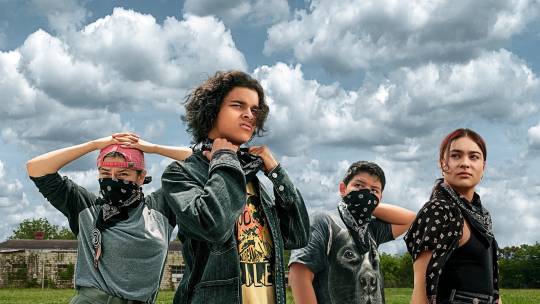
Reservation Roots.
For Indigenous People’s Day 2021, Leo Koziol explores the indie-film roots of Sterlin Harjo and Taika Waititi’s hit native series, Reservation Dogs.
Breakout FX on Hulu hit Reservation Dogs speaks directly to native audiences, each episode made lovingly by a bevy of native directors, actors and crew, many of whom found their storytelling voices through independent film. Anyone new to native cinema could do no better than to start their journey with a few choice cuts from these native talents.
The indie-film factor in Reservation Dogs’ success cannot be overstated. Television has a reach that other media do not, yet the path to primetime has never been easy. Any television project can die in development, fall at the pilot stage, or fail to be renewed after one measly season. For underrepresented storytellers, this road is even rougher.
To arrive on the small screen with a fully formed voice, there needs to have been a place to warm that voice up, and it’s more often been in the world of independent film that these opportunities lie for Indigenous artists.
Reservation Dogs is the brainchild of Taika Waititi (Te Whānau-ā-Apanui, Aotearoa) and Sterlin Harjo (Seminole/Muscogee Creek), who were both supported as indie darlings at Sundance under the watchful eye of recently retired native program director Bird Runningwater. (He has left the storied institute in order to produce his own projects.)
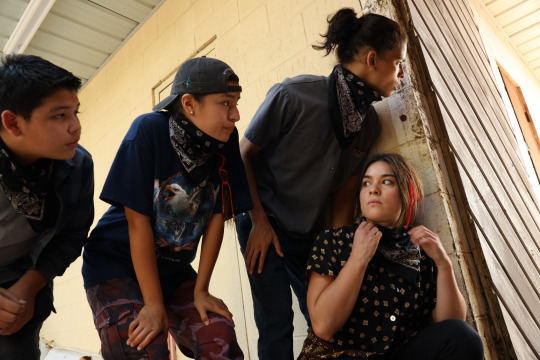
Lane Factor as Cheese, Paulina Alexis as Willie Jack, D’Pharaoh Woon-A-Tai as Bear, Devery Jacobs as Elora Danan Postoak in TV series ‘Reservation Dogs’.
Episodes were also directed by veteran natives Blackhorse Lowe (Navajo Nation) and Sydney Freeland, as well as performance poet and Bishop Paiute Tribe citizen Tazbah Rose Chavez (from the Nüümü, Diné and San Carlos Apache).
Between them, these five have made fifteen feature films (and won an Oscar), which represent a wellspring of native cinema ripe for rewatching or—going by many recent Letterboxd reviews who have come to them via Reservation Dogs—first-time discovery.
For aficionados of native cinema, Reservation Dogs is full of uniquely native humor (greasy fry bread, anyone?) and pop-culture references (main character Elora is named for the baby in Willow), but the most fun aspect for me has been the in-jokes. The Skux Soda cabinet at the native clinic (Hunt for the Wilderpeople fan service), a row of Māori dolls in a native rez store (co-creator Waititi is Māori) and, best of all, in episode five, an Oklahoma cinema marquee listing films by the four Native American directors of the series: Barking Water (Harjo), Drunktown’s Finest (Freeland), Fukry (Lowe) and Your Name Isn’t English (Chavez).
Waititi, the starrier of the two creators, whose feature works range from the awkward romance of Eagle vs Shark through to next year’s Thor: Love and Thunder, has certainly injected a careful balance of humor and emotion into the series. From his filmography, Reservation Dogs most resembles his 2010 semi-autobiographical comedy, Boy. But at heart, it is Harjo’s show—set in his home community of Oklahoma, and the culmination of fifteen years of filmmaking that serve as a calling card to its themes.
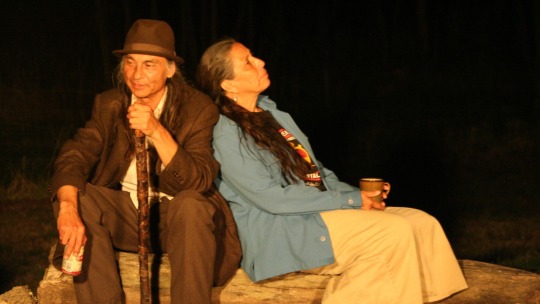
Richard Ray Whitman and Casey Camp-Horinek as Frankie and Irene in Sterlin Harjo’s ‘Barking Water’.
Stretching back to his beginnings, you can see two of Harjo’s best shorts on his YouTube channel. Goodnight Irene mirrors episode two of the series with malaise and humor in a native clinic; Three Little Boys directly mirrors the “kids on the Rez” ensemble of the show.
Then, in a trio of dramatic features, we see the progression as Harjo’s filmmaking skills grow alongside better budgets and resources. Letterboxd members are proudly noting the thematic similarities in his works. “Like Reservation Dogs, Harjo finds his most striking emotional moments in the quiet spaces between friends and family members,” writes Hannibal Montana of the first, Four Sheets To The Wind (2007).
CoterEB notes that Harjo’s 2009 follow-up, Barking Water, slots neatly into the Reservation Dogs storytelling family: “What Harjo absolutely succeeds at is letting the audience go along with it… It’s emotionally effective without manipulation.” It’s an approach that is further on display in his third feature, Mekko (2015), Hannibal Montana again recognizing that “much like Reservation Dogs, Mekko has one foot in a nostalgia for a lost, proud past and another in the immediate issues facing Indigenous people today, namely poverty, violence, and addiction”. (Hanabi Banana gives a more pointed review of this film, which I loved. Spoiler alert!)
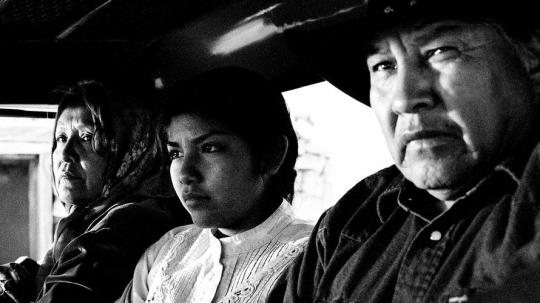
A still from Blackhorse Lowe’s 2009 short, ‘Shimásáni’.
Blackhorse Lowe is a long-time collaborator of Harjo’s; he was one of the editors of Mekko, and is also a Sundance alumnus. Lowe has a two-decade pedigree across many filmmaking departments and is a champion of genre-driven Indigenous films in New Mexico. His 2009 short Shimásáni is currently available on MUBI. He’s made three features, my favorite of which is Chasing The Light.
Writing about the 2014 film, Andy Nelson observes: “Lowe, also the cinematographer, captured some beautiful and haunting black-and-white imagery, which certainly helps add to the other world wanderings. It’s worth checking out, but the grittiness and raw drug comedy elements may be too much for a lot of people.”
I’m a huge fan of Lowe’s fellow Navajo director Sydney Freeland. You can watch her 2017 second feature, Deidra & Laney Rob A Train, on Netflix, but for me her best work to date is her first, Drunktown’s Finest (2014). Leonara Ann Mint writes of Freeland’s debut: “a very nuanced and powerful experience. Native American and trans voices are both way too rare in cinema, so to get both in the same film is often a revelation. All three plot lines here have depth, warmth and nuance, and by the end, the film had achieved a deep sense of emotional connectedness with each character that I won’t soon forget.”
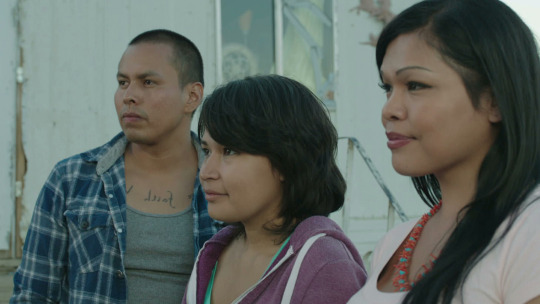
Jeremiah Bitsui, MorningStar Angeline and Carmen Moore in Sydney Freeland’s ‘Drunktown’s Finest’ (2014).
When Drunktown’s Finest was released, Freeland had not yet come out as a trans person (one of three stories in the Navajo-set film is of a trans woman, and how Navajo culture traditionally accepted those of a “third gender”). She’s gone on to cut a path in both LGBTQ storytelling and Indigenous film, and it’s wonderful to see her on the team for Reservation Dogs. Freeland is also directing episodes of Peacock’s Rutherford Falls, which shares creative talent with the Reservation Dogs collective. And with Harjo, she is making Rez Ball, a sports film for Netflix about the unique culture of Indigenous basketball.
In front of the camera, the ensemble cast of Reservation Dogs carries a film pedigree as deep as the directors behind it, and while many of the films they have appeared in are made by non-native writers and directors, their performances—and, in many ways their experiences on those sets—inform their work on Reservation Dogs.
Kahnawà:ke Mohawk actress Kawennáhere Devery Jacobs (credited as Devery Jacobs for her role as Elora) has played significant roles in Rhymes for Young Ghouls, the zombie outbreak gore-fest Blood Quantum and the Neil Gaiman series American Gods, as well as a number of short films, including Ara Marumaru for the Māoriland Film Festival Native Slam.
Dallas Goldtooth, who is Dakota and Dińe, appears on screen as the spirit of a warrior who died at Custer’s last stand. Goldtooth can also be seen as Rich Hall’s traveling companion in the comedian’s 2012 documentary re-examination of Native American stereotypes. Bear is played by Canadian actor D’Pharaoh Woon-A-Tai (of Oji-Cree, Anishinaabe and Guyanese descent) who has a breakout feature role in this year’s Beans, by Mohawk director Tracey Deer.
The cast also includes several veterans of the native film scene. First Nation media pioneer Gary Farmer, of the Cayuga Nation and Wolf Clan, has appeared in more than 50 films, including First Cow, Dead Man and Blood Quantum, and has been nominated three times for an Independent Spirit Acting Award.
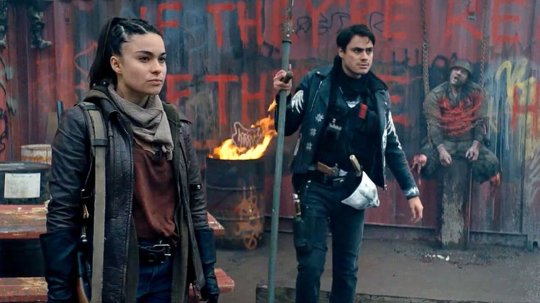
Devery Jacobs and Kiowa Gordon in ‘Blood Quantum’ (2019).
The legendary Cherokee star Wes Studi, who won an honorary Oscar at the 2019 Academy Awards, has had roles in numerous Hollywood blockbusters, including Dances With Wolves, The Last of the Mohicans and Avatar. My favorite Studi film is the comedy short, Ronnie BoDean, which you can watch for free on director Stephen Paul Judd’s Vimeo.
Nothing gets made without a script, and the brains in the Reservation Dogs writers’ room also have considerable roots in independent arts. Many of the crew, including Harjo and Goldtooth, are members of the 1491s, an Oklahoma-based native sketch comedy group. The 1491s are most famed for the 2019 Oregon Shakespeare Festival, where they premiered Between Two Knees, an intergenerational comedic love story/musical set against the backdrop of true events in native history.
1491s with writing credits on the show are poet and podcaster Tommy Pico (from the Viejas reservation of the Kumeyaay nation), Bobby Wilson (Sisseton-Wahpeton Dakota), who plays Marcus Werewolf in the What We Do in the Shadows television spinoff, and Migizi Pensoneau (Ponca/Ojibwe), who has several shorts on his filmography.
Right after the finale of series one, FX on Hulu announced Reservation Dogs season two and an expansion of its all-Indigenous writers’ room. Director Blackhorse Lowe joins the room, along with actors Jacobs and Goldtooth.
Other new writers in the room are Ryan RedCorn (Osage), who played Mike in Harjo’s Barking Water, Afro-Indigenous comedian and director Chad Charlie (Ahousaht First Nation), who made the 2020 short Uu?uu~tah and has another, Firecracker Bullets, coming next year, and award-winning writer-director Erica Tremblay (Seneca-Cayuga). Her 2020 short film Little Chief premiered at Sundance, and she is following in Waititi’s and Harjo’s footsteps as a Sundance Screenwriters and Directors Lab fellow.
The hope for both audiences and our industry is that Reservation Dogs won’t be a one-off. At the 2021 Emmy Awards, Harjo stood on stage and said, “We are here on television’s biggest night as creators and actors, proud to be Indigenous people working in Hollywood, representing the first people to walk upon this continent.”
Joined by his four leading actors, the group collectively stated: “Thankfully networks and streamers are now beginning to produce and develop shows created by and starring Indigenous people. It’s a good start, which can lead us to the day when telling stories from under-served communities will be the norm, not the exception. Because, like life, TV is at its best when we all have a voice.”
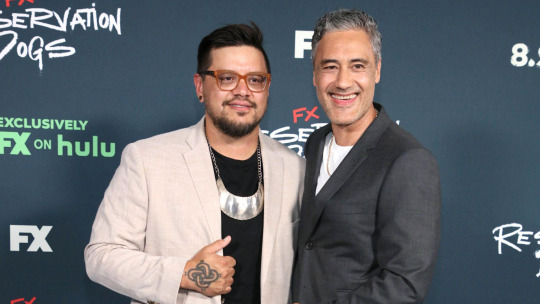
Sterlin Harjo and Taiki Waititi. / Photo by Robin Lori / INSTAR Images
As someone who for many years has followed the rise of native cinema from my home film festival, the arrival of this Stateside television hit marks a new day for native creatives. To Indigenous film fans, its creators are cult heroes who have been working for decades both in front of and behind the screen getting native American stories told, uncompromisingly.
I think about the collective talent that Sterlin and Taika have wrapped around the series, and I realize they simply contacted all their friends from past indie productions and said, hey, come work with us on this all-native production, we can pay you this time.
Related content
Leo’s list of the indie roots of Reservation Dogs
Reel Injun: a 2009 documentary by Catherine Bainbridge, Neil Diamond and Jeremiah Hayes about the Native American Hollywood experience
El Napalmo’s extensive Indigenous Cinema list
Dolores’ list of movies in which the main native character is in fact white
Beans is released in select theaters and on demand on November 5
Follow Leo on Letterboxd
#reservation dogs#taika waititi#sterlin harjo#tracey deer#beans#fx on hulu#rez dogs#leo koziol#maori movies#indigenous film#indigenous filmmaker#indigenous director#native american director#indigenous people's day
30 notes
·
View notes
Text
Complexity Explained
Complexity Explained
https://t.co/hn2xX3cFdO
Credits
Coordinators:
Manlio De Domenico and Hiroki Sayama
Contributors:
Manlio De Domenico, Dirk Brockmann, Chico Camargo, Carlos Gershenson, Daniel Goldsmith, Sabine Jeschonnek, Lorren Kay, Stefano Nichele, José R. Nicolás, Thomas Schmickl, Massimo Stella, Josh Brandoff, Ángel José Martínez Salinas, Hiroki Sayama
Thanks to the following who provided inputs and feedback:
Hayford Adjavor, Alex Arenas, Yaneer Bar-Yam, Rogelio Basurto Flores, Michele Battle-Fisher, Anton Bernatskiy, Jacob D. Biamonte, Victor Bonilla, Dirk Brockmann, Victor Buendia, Seth Bullock, Simon Carrignon, Xubin Chai, Jon Darkow, Luca Dellanna, David Rushing Dewhurst, Peter Dodds, Alan Dorin, Peter Eerens, Christos Ellinad, Diego Espinosa, Ernesto Estrada, Nelson Fernández, Len Fisher, Erin Gallagher, Riccardo Gallotti, Pier Luigi Gentilli, Lasse Gerrits, Nigel Goldenfeld, Sergio Gómez, Héctor Gómez-Escobar, Alfredo González-Espinoza, Marcus Guest, J. W. Helkenberg, Stephan Herminghaus, Enrique Hernández-Zavaleta, Marco A. Javarone, Hang-Hyun Jo, Pedro Jordano, Abbas Karimi, J. Kasmire, Erin Kenzie, Tamer Khraisha, Heetae Kim, Bob Klapetzky, Brennan Klein, Karen Kommerce, Roman Koziol, Erika Legara, Carl Lipo, Oliver Lopez-Corona, Yeu Wen Mak, Vivien Marmelat, Steve McCormack, Dan Mønster, Alfredo Morales, Yamir Moreno, Ronald Nicholson, Enzo Nicosia, Sibout Nooteboom, Dragan Okanovic, Charles R Paez, Julia Poncela C., Francisco Rodrigues, Jorge P. Rodríguez, Iza Romanowska, Pier Luigi Sacco, Joaquín Sanz, Samuel Scarpino, Alice Schwarze, Nasser Sharareh, Keith Malcolm Smith, Ricard Sole, Keith Sonnanburg, Cédric Sueur, Ali Sumner, Michael Szell, Ali Tareq, Adam Timlett, Ignacio Toledo, Leo Torres, Paul van der Cingel, Ben van Lier, Jeffrey Ventrella, Alessandro Vespignani, Joe Wasserman, Kristen Weiss, Daehan Won, Phil Wood, Nicky Zachariou, Mengsen Zhang, Arshi, Brewingsense, Complexity Space Consulting, Raoul, Systems Innovation, The NoDE Lab
Special thanks to Dirk Brockmann for his Complexity Explorables and to Serafina Agnello for designing and realizing the booklet.
via
June 28, 2019 at 03:29PM
0 notes
Text
Peter Pilz und die Eurofighter-Lüge
Neuer Beitrag veröffentlicht bei https://melby.de/peter-pilz-und-die-eurofighter-luege/
Peter Pilz und die Eurofighter-Lüge
Heute ringt der einstige „Aufdecker“ Peter Pilz für alle sichtbar um sein politisches Überleben und hat dabei massive Glaubwürdigkeitsprobleme. Dies jedoch weniger, weil seine Lügen durchschaut werden, sondern weil er sich selbst ein Gehalt genehmigte, aber eine Auszeit nahm, und es in seiner Liste drunter und drüber geht. So klang er hingegen noch im Februar: „Je einfacher der Sachverhalt ist, desto gefährlicher ist es für den Beschuldigten.“ Gemeint ist Ex-Verteidigungsminister Norbert Darabos, den Pilz vor einem Jahr wegen des Vergleichs mit Eurofighter angezeigt hat. Pilz rechne „fix mit einer Anklage“, schrieb der „Kurier“ da, „außer Darabos hilft bei der Aufklärung mit und nennt die Hintermänner“. Drohungen im Mafia-Stil sind typisch der alte Pilz, siehe auch am 31. Mai 2017 vor Darabos‘ Aussage im Eurofighter-U-Ausschuss: „Pilz stellt Darabos ein Ultimatum“, verkündete der „Kurier“ da: „Entweder packt Darabos aus, wer die Hintermänner sind, oder er muss die gesamte Verantwortung alleine tragen.“ Die Redakteurin jubelte mit Pilz: „Das grüne Urgestein schreckt vor einer Anzeige nicht zurück.“
Im Februar 2018 zitiert der „Kurier“ Pilz auch mit dieser Aussage: „Ich denke, dass dieser Deal Darabos angeschafft wurde. Wenn ja, hat er jetzt erstmals ein Motiv auszupacken, wer es wirklich war.“ Wir erleben hier nicht nur einen anderen Pilz als heute, dieser ist zu diesem Zeitpunkt auch nicht mehr immun und man kann hier z.B. an den Verdacht der Nötigung eines Mitglieds eines verfassungsmäßigen Vertretungskörpers denken, das Landesrat Darabos ja ist. Pilz ist in eigener Sache ungeheuer wehleidig, wie man dieser Tage auf seiner Webseite sehen kann, und er ist auch verlogen, da er niemals bereute, wie er mit anderen umgeht, sonst würde er wiedergutmachen, was er ihnen angetan hat. Interessant ist, dass die Justiz wie auf Knopfdruck funktionierte, obwohl Pilz ja offenbar selbst von „Hintermännern“ weiß und öffentlich sagte, dass Darabos – den er wegen Untreue anzeigt – nicht korrupt sei. Pilz hängt seine Anzeige am 24. Mai 2007 auf, als im Gartenhotel Altmannsdorf (damals noch im Besitz der SPÖ) ein Vertragsentwurf unterschrieben wurde: „Für den heutigen burgenländische Landesrat war der Vertrag von Altmannsdorf ’nur eine Skizze‘ wie der Vergleich ausschauen könnte. ‚Wenn ich ein handschriftliches Papier unterschreibe, ist das für mich noch kein Vergleich über 370 Millionen Euro‘, rechtfertigt sich Darabos gegenüber dem KURIER. Hier scheint der Ex-Heeresminister von seinem Juristen Helmut Koziol nicht sehr gut beraten gewesen zu sein. Denn Rechtsexperten sagen unisono, dass das Altmannsdorfer-Übereinkommen alle Bedingungen eines rechtsgültigen Vertrages erfüllt.“
Peter Pilz bei der „Kronen Zeitung“ 2017 (Twitter)
Paradoxer Weise orientierte sich Pilz bei der Anzeige aber an der zehnjährigen Verjährungsfrist gerechnet vom 24. Juni 2007. Der 24. Mai spielt auch am 31. Mai 2017 eine Rolle, also an dem Tag, als Pilz Darabos vor dessen Aussage drohte (was Verfahrensanwalt Ronald Rohrer offenbar nicht weiter aufgefallen ist): „Was wird Darabos vorgeworfen? Die wahrscheinlich schwerste Anschuldigung lautet, dass sich Darabos von EADS das Verhandlungsteam auf österreichischer Seite diktieren ließ und wie eine Marionette agiert haben soll. Jene, die lästige Fragen stellten, wurden wieder ausgeladen. „Das bestätigt auch die Rechnungshof-Abteilungsleiterin Caesar-Stifter: ‚In der Phase, wo Peschorn nicht mehr dabei war, haben wir keinerlei Dokumentation.‘ Peschorn schildert seinen Rauswurf am Abend des 24. Mai 2007 so: Er bekam ‚einen Anruf von Kabinettschef Stefan Kammerhofer‚, der ihm mitteilte: ‚Eurofighter möchte nicht mit Ihnen die Verhandlungen führen.‘ Diesen Wunsch hatte der EADS-Vorstand Aloysius Rauen gegenüber dem Minister geäußert. Der U-Ausschuss brachte auch ans Tageslicht, dass hinter dem Rücken Peschorns schon Parallelverhandlungen mit EADS stattfanden. Später habe, ebenfalls auf Wunsch von EADS, auch der Mann für die militärische Expertise Erwin Jeloschek das Verhandlungsteam verlassen müssen. Nur noch Darabos und sein juristischer Berater Helmut Koziol, der für seine Beratung 112.000 Euro kassierte, führten die finalen Gespräche.“
Hier war jedoch noch nicht vom Papier von Altmannsdorf die Rede, das Peter Pilz am 2. Juni 2017 (dem Tag nach Darabos‘ Aussage) triumphierend dem Rektor der Linzer Kepler-Universität Meinhard Lukas vorlegte, der am 24. Mai dabeigewesen ist. In den Ausschuss gelangte es via Verteidigungsressort, doch ein paar Wochen zuvor hatten es Grüne und FPÖ bereits in Händen. Als Wolfgang Peschorn, als Leiter der Finanzprokuratur der „Anwalt der Republik“, den Darabos mit den Verhandlungen beauftragte, hinausgekickt wurde, hatte man sich bereits ohne ihn in Altmannsdorf getroffen. Sowohl er als auch Darabos sagten aber im U-Ausschuss, dass sich nichts an der Beauftragung geändert hat, was impliziert, dass Kammerhofer Peschorn eigenmächtig entfernte bzw. einen fremden Auftrag erhalten hat. „Sein“ juristischer Berater ist ein Scherz, da Koziol, der ein Theoretiker ohne Verhandlungserfahrung ist, über Leo Specht, den Anwalt, Freund und inzwischen auch Geschäftspartner von Ex-Bundeskanzler Alfred Gusenbauer ins Spiel kam. Man muss auch bedenken, dass es damals parallel den 1. Eurofighter-Ausschuss gab, in dem die SPÖ u.a. von Hannes Jarolim, einem früheren Specht-Kanzleipartner vertreten wurde, dessen Sozietät übrigens einen Luftfahrt-Schwerpunkt hat. Als Norbert Darabos am 7. Mai 2007 zum ersten Mal im Ausschuss aussagte, hatte er Kammerhofer als „Vertrauensperson“ mit, die ihm jede Antwort vorsagte, was Maria Fekter (ÖVP) vor Darabos‘ zweiter Befragung am 14. Juni kritisierte.
SPÖ-Wahlwerbung 2006
Zeugenbeeinflussung ist nicht nur durch Drohgebärden u.a. via „Kurier“ strafbar, sodass der Ausschussvorsitzende Peter Pilz Fekter energisch zurechtwies, da ja nicht der Eindruck entstehen darf, Darabos sei unter Druck. Es traf sich gut, dass am 13. Juni Abwehramtschef Erich Deutsch befragt wurde, der zugeben musste, dass Kammerhofer nicht überprüft wurde und man auch keinerlei Verdachtsmomenten nachging. Es war also nicht merkwürdig, dass es unter höheren Offizieren hieß, „an Kammerhofer gibt es kein Vorbeikommen“ oder dass die Presseabteilung nicht wie zuvor Briefings mit dem Minister hatte, sondern „Papiere aus dem Ministerbüro“ bekam. Der umgekehrte Fall, dass ein Schreiben des Generalstabschefs an den Minister diesem vorenthalten wurde, spielt gerade in der Golan-Affäre eine Rolle. Als der Bericht der Golan-Untersuchungskommission präsentiert wurde, bemühte diese sich darum, Kammerhofers Rolle zu kaschieren und so zu tun, als sei Darabos eh informiert worden. Die Abgeordnete Maria Fekter, die sich intensiv auf den U-Ausschuss vorbereitet hatte, wurde also stutzig und stellte dem Abwehrchef Fragen, um Gewißheit zu bekommen, trat dann gegen Kammerhofers Aufpasserrolle ein und wurde von Pilz zurechtgewiesen. Das sieht danach aus, dass Pilz und Kammerhofer unter einer Decke stecken und dazu auch Specht und Gusenbauer gehören. Was Koziol betrifft, der im April 2007 zuerst für ein Gutachten ins Spiel kam, ist wenig überraschend jetzt von Kontakten mit dem damaligen Eurofighter-Rechtsberater Meinhard Lukas die Rede. Pilz führte lange ein politisches Tagebuch, das auf einen Deal im Hintergrund hinweist, der ihn stets einbezogen hat.
Am 7. Mai 2007, also als Darabos jede Antwort von „Vertrauensperson“ Kammerhofer vorgesagt wurde, zitierte er auch eine Mail, die Rauen bei seiner U-Ausschuss-Befragung erwähnte: „Sehr geehrter Herr Bundesminister, Anfang der Woche hatte ich Sie angerufen, als Sie gerade auf dem Weg zu einem Termin in Wien unterwegs waren. Der Grund meines Anrufes war – wie ich Ihnen mitteilte – die dringend notwendige Absprache der weiteren Vorgangsweise nach unserem persönlichen Gespräch in der Vorwoche ebenfalls in Wien. Sie wollten mich dazu zurückrufen, was leider bis heute nicht erfolgt ist. Ich muss Ihnen daher auf diesem Wege mitteilen, dass wir aufgrund der jüngsten Entwicklungen in Wien für die Fortführung unserer vertraulichen Gespräche derzeit keine Basis mehr sehen. Men Team wird daher am morgigen Freitag nicht nach Salzburg reisen. Ihr Dr. P. wurde entsprechend informiert.‘ …“ Mit Dr. P. ist natürlich Peschorn gemeint, der wie Rauen von den verdeckten Manövern der Hintermänner von Pilz und Kammerhofer betroffen war, ohne da durchzusteigen.
EADS-Mail vom 13.12. 2006: Darabos als Minister
Typisch für den alten Pilz ist, dass er alles scheinbar erklärt und damit falsche Fährten legt; „Rauen sieht eine letzte Chance: Er muss mit dem Minister zu einem Vergleich kommen, bevor der Endbericht des Ausschusses fertig ist. Darabos hat es nicht so eilig. Die Zeit arbeitet für ihn. Trotzdem lässt der Minister dem Konzern die Tür einen Spalt offen. Er schließt den voreiligen Vergleich nicht aus. Sachlich ergibt das keinen Sinn, politisch aber schon. Darabos muss auf Gusenbauer Rücksicht nehmen, und Gusenbauer will nur eines: in Ruhe Kanzler bleiben.“ Als Österreich nicht aus dem Vertrag mit EADS aussteigt, sondern der Vergleich geschlossen wird, macht Pilz (wessen?) Ärger über Gusenbauer Luft, dem das Kanzleramt wichtiger ist als alles andere. Dass der abgeschottete und unter Druck gesetzte, rundum überwachte Darabos Rauen nicht zurückruft, passt ins von Pilz verschleierte Bild. Übrigens folgte Rauen einer Ladung in den 2. Ausschuss nicht, was er als Deutscher auch nicht mußte. Kammerhofer kommt beim „Aufdecker“ nur ein einziges Mal und da positiv vor und spielte beim 2. Ausschuss keine Rolle, obwohl er am 8. Juni 2017 befragt wurde. Da Pilz immer schon andere vollkommen skrupellos benutzt und so getan hat, als verfolgte man ein gemeinsames Ziel, sind jene Passagen seines Tagebuchs besonders aufschlussreich, in denen Darabos öfter vorkommt. Etwa am 25.Juni 2007: „Es war eine geheime Kommandosache. Das Kabinett, der Generalstab – niemand durfte etwas wissen. Nur der Eurofighter-Chef, der Partei-Chef und ein paar wenige waren eingeweiht, als Norbert Darabos heute Vormittag zum Eurofighter-Finale antrat. Unsere Arbeitsteilung mit dem Minister hat bis jetzt gut funktioniert.“ Wer ist „unsere“, wenn der Minister abgeschottet, überwacht, unter Druck gesetzt wird? Pilz schreibt von einem eingeweihten Partei-Chef, lässt aber Gusenbauer u.a. am 22. Juni 2017 damit davonkommen, dass alles Ministerverantwortung sei und er auch keine Ahnung vom Vertragsentwurf vom 24. Mai 2007 hatte.
„Der Untersuchungsausschuss schafft Fakten und erarbeitet eine starke Position der Republik. Das haben wir getan.“ Mitwirkende erinnern sich mit Schaudern daran, wie rüde Pilz mit Zeugen verfuhr, die ihm nicht zu Gesicht standen – diese waren merkwürdigerweise auch anonymen Anzeigen ausgesetzt. „Noch nie war der Verteidigungsminister in einer sachlich besseren Lage. Seine Aufgabe baut auf unserer Arbeit auf. Er muss verhandeln und entscheiden. Dabei arbeitet die Zeit für ihn. Wenn Norbert Darabos noch eine Woche die Nerven bewahrt und dem Druck von EADS, ÖVP und Kanzler standhält, wäre vom Ausstieg bis zu einem großen Verhandlungserfolg alles drin. Aber Darabos verhandelt so, wie es uns die SPÖ bei der Bildung der Regierung vorgezeigt hat. Ein geschwächter Eurofighter-Chef ist immer noch stark genug, den Minister mit einem kleinen Ruck über den Tisch zu ziehen.“, schrieb Pilz. Selbst wenn Darabos nicht unter Druck stehen würde, wäre es immer noch typisch Pilz-zynisch, andere herunterzumachen, in deren Schuhen er nicht steht. Warum hat er eine Band „Prinz Pezi und die Staatssekretäre“ genannt (anbetracht seiner Übergriffigkeits-Troubles kann man wohl „Prinz Pezi und die Impotenten“ sagen), wenn nicht, weil die Trauben zu sauer sind?
youtube
Pilz auf der Bühne
Ein Regierungsamt war für den Agenten Pilz immer unerreichbar, und seinetwegen hatten die Grünen auch keine Chance. Deshalb wird auf den Minister hingetreten, den er am 14. Juni 2007 auch auf bizarre Weise im U-Ausschuss begrüßte: „Wir kommen zur Anhörung vom Herrn Bundesminister Norbert Darabos. Ich danke für Ihr Erscheinen. Vor Ihrer Anhörung muss ich Sie auf Ihre Pflicht zur Angabe der Wahrheit und die strafrechtlichen Folgen einer falschen Aussage erinnern. Eine vorsätzlich falsche Aussage vor dem Untersuchungsausschuss wird gemäß § 288, ach so. Entschuldigung, heute ist der Tag wo ich immer auf den ORF und den Kameraschwenk vergesse. Ich bitte den schnell durchzuführen. Um diese schönen Fotos wird der Herr Bundesminister noch jahrelang beneidet werden. Die sind jetzt angefertigt. Der Dr. Strasser leidet bereits. (Verfahrensanwalt Gottfried Strasser, Anm.) Danke schön, mein zweiter Dank und es folgt mein dritter und letzter Dank. Es ist ausgedankt. Ich begrüße Herrn Bundesminister Darabos im Ausschuss. Ich danke für Ihr Erscheinen.“ Man mag sich fragen, ob Pilz (der Ausschussvorsitzende!) noch alle Tassen im Schrank hat; doch wenig später weist er auch Maria Fekter zurecht, weil sie die Beaufsichtigung des Ministers durch Kammerhofer kritisiert.
Am 25. Juni 2007 demaskierte er sich auch mit diesen Worten: „Darabos wackelt zwischen die Fronten. Die ÖVP wartet darauf, ihn in der Eurofighter-Familie willkommen zu heißen. Und wir erinnern an zweierlei: an die große Chance, weit mehr als eine Milliarde Euro einzusparen; und an das, was es in der SPÖ nach Eurofighter nicht mehr gibt: an ein gehaltenes Wahlversprechen.“ Dazu sei bemerkt, dass die SPÖ 2002 gegen Abfangjäger und 2006 gegen Eurofighter wahlkämpfte, stets mit Tal Silberstein als Berater. Und dass es offensichtlich um die amerikanische Rüstungsfamilie, etwa um Lockheed und Boeing geht. Lockheed ist seit dem Project Wild Cherry (Spionageflugzeuge) mit der CIA verbandelt, was auch seit den 1980er Jahren auf John Podesta zutrifft, dessen Bruder Tony bis Herbst 2017 Lockheed-Lobbyist war. Nun wird gegen Tony Podesta wegen Lobbying für die Ukraine ermittelt, was auch für Paul Manafort gilt, der u.a. Alfred Gusenbauer engagierte. Es gibt noch eine Bedeutung des 24. Mai 2007 neben dem Vertragsentwurf und dem Hinauswurf von Peschorn aus den Verhandlungen, nämlich ein Galadiner in Schönbrunn zugunsten der Clinton Foundation, zu dem – da sich Gusenbauer darum sehr bemüht hatte – Bill Clinton höchstpersönlich anreiste. John Podesta war Clintons Stabschef, arbeitete auch für Obama und leitete dann den Wahlkampf von Hillary Clinton.
youtube
Video von 2017
Wir wissen aus dem 2. U-Ausschuss, dass der Rechnungshof das Aussetzen jeglicher Dokumentation beklagte, als Peschorn nicht mehr mit von der Partie war. Dies führte zu aberwitzigen Schlußfolgerungen der von Pilz an der Nase herumgeführten Abgeordneten, die Darabos die kühne Ausschaltung des Finanzministers und der Regierung unterstellten und vollkommen seine tatsächliche Lage ausblendeten. Wenn ein Minister aber nicht nur das frei tun kann, was er wirklich darf und soll, sondern auch ganz ungehindert das, was er nicht tun soll, müsste er imstande sein, jede Person zu treffen, die er treffen will. So aber brachten die Parlamentarier damit in Einklang, dass Experten des BMLV kein einziges Mal mit ihm reden konnten, obwohl/weil sie am Vertrag mit EADS mitgewirkt hatten. Wahrscheinlich war es Darabos erlaubt, sich Papierkram anzusehen, den er dann aber selbst bewerten musste; man ließ ja auch stets einen hohen Stapel Papier im Dienstwagen mitführen, um den Schein nach außen zu wahren. Ein Minister in Geiselhaft wird zum Teil Dinge tun müssen, die normal wirken, also da und dort Hände schütteln, gelegentlich eine Pressekonferenz geben usw. Man kann es jedoch anhand von natürlichem Verhalten und spontanen Reaktionen bewerten, die z.B. nicht möglich waren, als die Wehrpflicht-Volksbefragung fixiert wurde und zunächst alle anderen etwas sagten, aber Darabos erst nach Wochen auftrat.
Peschorns Ausschluss wurde vorbereitet, indem sich Kammerhofer mit ihm anfreundete, mit ihm essen ging, wie der 2. U-Ausschuss ans Licht brachte. Denn man akzeptiert es ohne nachzufragen, wenn einen ein Freund hinauswirft, da es dann wohl nicht persönlich gemeint ist. Zudem passt es zum weitgehenden Fehlen von Schriftlichem, was auch Ministerweisungen betrifft, die ja belegbar sein müssen. Da Kammerhofer mit „mach‘ das, der Minister will das so“ herumlief, muss man alles untersuchen, was von 2007 bis 2016 im BMLV passiert ist. Beliebt waren auch „Aktennotizen“, die kompensieren sollten, dass jede Kammerhofer-„Weisung“ ein rechtsungültiger Weisungsversuch ist, der in seinen Auswirkungen rückgängig zu machen ist. Mit dem Vorenthalten von Informationen und persönlichen Kontakten wurden nicht nur Darabos‘ Menschenrechte verletzt, sondern in der Verletzung seiner Ministerrechte wird ihm jetzt mit der Anzeige von Agent Pilz daraus ein Strick gedreht. Es entsteht der Eindruck, dass Gusenbauer dem Plan des Vertragsausstiegs sozusagen von der Schippe sprang, aber die gleichen Herren wie Pilz hatte; was man ohne Expertise und mit einem Theoretiker als Verhandler „für die Repubkik“ zusammenschusterte, diente so allerdings auch nicht der Luftraumüberwachung. EADS muss das Gefühl bekommen haben, dass man diesem Kunden nicht zu seinem Glück raten kann, ihm daher den scheinbaren Willen lassen sollte – wenngleich dies dann jahrelange Beschwerden und Imageschaden zur Folge hatte.
Ausschussbericht der Grünen 2009 (zu Abhörmaßnahmen)
Als Hans Peter Doskozil Minister wurde, fand Pilz sogar noch einen Dummen, den man dazu überreden konnte, einen Vertragsausstieg zehn Jahre nach Beginn der Eurofighter-Nutzung anzustreben. Und Prinz Pezi konnte am 26. Juni 2007 über einen Getretenen jubeln: „Norbert Darabos liegt am Boden und ist erleichtert. Militärs und Mitarbeiter haben mir gestern alle dasselbe erzählt: Der Minister hat dem Druck nicht mehr standgehalten. EADS, Eurofighter, ÖVP, Gusenbauer – das war schon seit Wochen zu viel. Von einem fremden Haus aus, das er bis heute nicht versteht, sollte er einen Dreifrontenkrieg führen. Gestern war ihm bereits alles recht. Darabos hat kapituliert.“ Als „fremd“ kann man das BMLV deshalb bezeichnen, weil hier ja via Kammerhofer fremd regiert wurde und Darabos ab 2009 als auch-Sportminister ohnehin ins Haus des Sports abgeschoben wurde, statt sich in der Regel im BMLV aufzuhalten. Wenn man dem Minister aber auch nur selten bloß z.B. am Gang begegnet, geschweige denn bei Besprechungen mit ihm ist, wird er als „Phantom“ bezeichnet und dank medialem Narrativ ist dann von Desinteresse die Rede, das Offensichtliche wird nicht erkannt.
Das Norbert Darabos auch für die SPÖ nur eine Schachfigur in einem zynischen „Spiel“ ist, sieht man an diesem Pilz-Eintrag vom 22. Juli 2007: „Hat die SPÖ eine Strategie? Im Jänner hat sie selbst einen strategischen Versuch unternommen. Mit dem Ausklammern der Eurofighter aus dem Regierungsübereinkommen und dem Freibrief für den Untersuchungsausschuss wollte die SPÖ die ÖVP von Anfang an in die Defensive drängen. Der Plan war klar: Die SPÖ verzichtet für das sonst eher unwichtige Verteidigungsministerium auf den Innenminister. Der Verteidigungsminister hatte nur eine politische Aufgabe: den Ausstieg aus dem Vertrag. Der Ausschuss sollte ihm dafür die Gründe liefern. Mit Norbert Darabos wurde für diese strategische Schlüsselaufgabe ein verlässlicher, aber persönlich und sachlich unsicherer Funktionär gewählt.“ Wie Wolfgang Schüssel am 20. Juni 2017 im U-Ausschuss betonte, stand Darabos unter immensem Druck und wurde gegen seinen Willen Minister. Das bedeutet jedoch zugleich, dass er das Amt dann bestmöglich ausüben wollte – vorausgesetzt, das Abwehramt nimmt seine Aufgabe wahr und schützt ihn, was jedoch mit dem zutiefst kompromittierten Leiter Deutsch und auch später nicht der Fall war. Man kann in streng hierarchischen Strukturen mit etablierten Abläufen ungeheuer einfach den obersten Verantwortlichen in Geiselhaft nehmen, da er z.B. von stur Gehorchenden, die ihn „schützen“, von anderen abgeschottet wird.
youtube
Satire auf die Liste Pilz
Es sei noch einmal auf den „Kurier“ vom 31. Mai 2017 verwiesen: „Über die Endgespräche in Paris gebe es ‚kein Fuzerl Papier‘ in den Unterlagen, kritisiert Pilz. Am 28. Mai ereilte den Leiter der Finanzprokuratur ein neuerlicher brisanter Anruf. Dieses Mal von EADS-Vertreter Peter Mauthe. Die Botschaft des Gesprächs war, dass ‚über das Pfingstwochenende eine politische Entscheidung‘ getroffen wird. Für Pilz ein Indiz, dass Ex-Kanzler ‚Gusenbauer involviert war.‘ Die möglichen Schäden des Vergleich-Deals wurden gestern plakativ aufgearbeitet. So fehlen, laut Caesar-Stifter, ‚wesentliche Kalkulationsunterlagen‘, etwa zur vereinbarten Abbestellungspauschale von 57 Millionen Euro. Als Begründung, warum es keine Auflistung gibt, bekam der Rechnungshof vom Verteidigungsministerium die flapsige Antwort, dass es ja der ‚Sinn einer Pauschale sei, dass es keine genaue Kalkulation gibt‘.“ Das klingt ganz nach Kammerhofer, da man bei „Ministerium“ eben nicht automatisch „Minister“ denken darf. Und man erinnere sich an überteuerte Ersatzteilrechnungen, bei denen sich fragt, ob da wohl jemand mitgeschnitten hat (und ob das die Justiz interessiert). Als Kammerhofer am 24. Jänner 2011 Generalstabschef Edmund Entacher abberief und sich Darabos wieder einmal fügen musste, gab es eine erfolgreiche Berufung, in der auf Artikel 20 Absatz 1 der Bundesverfassung verwiesen wurde. Einzig der Minister hat das Weisungsrecht; Kammerhofer durfte nur echte Ministerweisungen eins zu eins weitertragen und sonst nichts.
Es wurde bemängelt, dass es kaum schriftliche Ministerweisungen, also nur wenig an erkennbarem tatsächlichem Ministerwillen gibt – um den es sich z.B. beim Auftrag an Peschorn gehandelt hatte. „Aufdecker“ Pilz benutzte den U-Ausschuss, der auf sein Betreiben zustande kam, um eine Lüge zu erzählen und den Ex-Minister auf Basis dieser Lüge anzuzeigen. Immer noch verbinden manche Hoffnungen mit dem „Aufdecker“ Pilz, auf dass wir jetzt endlich beim 3. Eurofighter-Ausschuss all die Briefkastenfirmen aufspüren, mit denen er jahrelang wedelte. Man hört aus den Reihen der letzten Pilz-Anhänger, dass ihr Idol immer wieder von engen Kontakten zu SPÖ-Chef Christian Kern sprach. Dieser hat sein politisches Schicksal in gewisser Weise auch an den „Aufdecker“ geknüpft, der sich brüstete, dass er den Roten Know How und Informationen zur BVT-Affäre liefern kann. So nach dem Motto: ich habe das Wissen, ihr habt die Abgeordneten für einen U-Ausschuss. Doch jetzt steht Pilz erstmal selbst wegen der Eurofighter vor Gericht, weil ihn ein Staatsanwalt wegen übler Nachrede geklagt hat. Denn natürlich kann es nur mit Korruption zu tun haben, wenn ein Verfahren eingestellt wird.
Gefällt mir:
Gefällt mir Lade …
Ähnliche Beiträge
Ceiberweiber
alexandrabader
Quelle
قالب وردپرس
0 notes
Photo

Noir Zealand Road Trip.
Breakout noir filmmaker James Ashcroft speaks to Letterboxd’s Indigenous editor Leo Koziol about his chilling new movie Coming Home in the Dark—and reveals how Blue Velvet, Straw Dogs and a bunch of cult New Zealand thrillers are all a part of his Life in Film.
“Many different types of feet walk across those lands, and the land in that sense is quite indifferent to who is on it. I like that duality. I like that sense of we’re never as safe as we would like to think.” —James Ashcroft
In his 1995 contribution to the British Film Institute’s Century of Cinema documentary series, Sam Neill described the unique sense of doom and darkness presented in films from Aotearoa New Zealand as the “Cinema of Unease”.
There couldn’t be a more appropriate addition to this canon than Māori filmmaker James Ashcroft’s startling debut Coming Home in the Dark, a brutal, atmospheric thriller about a family outing disrupted by an enigmatic madman who calls himself Mandrake, played in a revelatory performance by Canadian Kiwi actor Daniel Gillies (previously best known for CW vampire show The Originals, and as John Jameson in Spider-Man 2). Award-winning Māori actress Miriama McDowell is also in the small cast—her performance was explicitly singled out by Letterboxd in our Fantasia coverage.
Based on a short story by acclaimed New Zealand writer Owen Marshall, Ashcroft wrote the screenplay alongside longtime collaborator Eli Kent. It was a lean shoot, filmed over twenty days on a budget of just under US $1 million. The film is now in theaters, following its premiere at the Sundance Film Festival in January, where it made something of an impact.

Erik Thomson, Matthias Luafutu, Daniel Gillies and Miriama McDowell in a scene from ‘Coming Home in the Dark’.
Creasy007 described the film as “an exciting New Zealand thriller that grabs you tight and doesn’t let you go until the credits are rolling.” Jacob wrote: “One of the most punishingly brutal—both viscerally and emotionally—first viewings I’ve enjoyed in quite a while. Will probably follow James Ashcroft’s career to the gates of Hell after this one.”
Filmgoers weren’t the only ones impressed: Legendary Entertainment—the gargantuan production outfit behind the Dark Knight trilogy and Godzilla vs. Kong—promptly snapped up Ashcroft to direct their adaptation of Devolution, a high-concept novel by World War Z author Max Brooks about a small town facing a sasquatch invasion after a volcanic eruption. (“I find myself deep in Sasquatch mythology and learning a lot about volcanoes at the moment,” says the director, who is also writing the adaptation with Kent.)
Although Coming Home in the Dark marks his feature debut, Ashcroft has been working in the creative arts for many years as an actor and theater director, having previously run the Māori theater company Taki Rua. As he explains below, his film taps into notions of indigeneity in subtle, non-didactic ways. (Words in the Māori language are explained throughout the interview.)
Kia ora [hello] James. How did you come to be a filmmaker?
James Ashcroft: I’ve always loved film. I worked in video stores from the age thirteen to 21. That’s the only other ‘real job’ I’ve ever had. I trained as an actor, and worked as an actor for a long time. So I had always been playing around with film. My first student allowance that I was given when I went to university, I bought a camera, I didn’t pay for my rent. I bought a little handheld Sony camera. We used to make short films with my flatmates and friends, so I’ve always been dabbling and wanting to move into that.
After being predominantly involved with theater, I sort of reached my ceiling of what I wanted to do there. It was time to make a commitment and move over into pursuing and creating a slate of scripts, and making that first feature step into the industry. My main creative collaborator is Eli Kent, who I’ve been working with for seven years now. We’re on our ninth script, I think.
But Coming Home in the Dark, that was our first feature. It was the fifth script we had written, and that was very much about [it] being the first cab off the rank; about being able to find a work that would fit into the budget level that we could reasonably expect from the New Zealand Film Commission. I also wanted to make sure that piece was showing off my strengths and interests—being a character-focused, actor-focused piece—and something that we could execute within those constraints and still deliver truthfully and authentically to the story that we wanted to tell and showcase the areas of interest that I have as a filmmaker, which have always been genre.
Do you see the film more as a horror or a thriller?
We’ve never purported to be a horror. We think that the scenario is horrific, some of the events that happen are horrific, but this has always been a thriller for me and everyone involved. I think, sometimes, because of the premiere and the space that it was programmed in at Sundance, being in the Midnight section, there’s a sort of an association with horror or zany comedy. For us it’s more about, if anything, the psychological horror aspect of the story.
It’s violent in places, obviously, but there’s very little violence actually committed on screen. It’s the suggestion. The more terrifying thing is what exists in the viewer’s mind [rather] than necessarily what you can show on screen. My job as a storyteller is to provoke something that you can then flesh out and embellish more in your own psyche and emotions. It’s a great space, the psychological thriller, because it can deal with the dramatic as well as some of those more heightened, visceral moments that horror also can touch on.
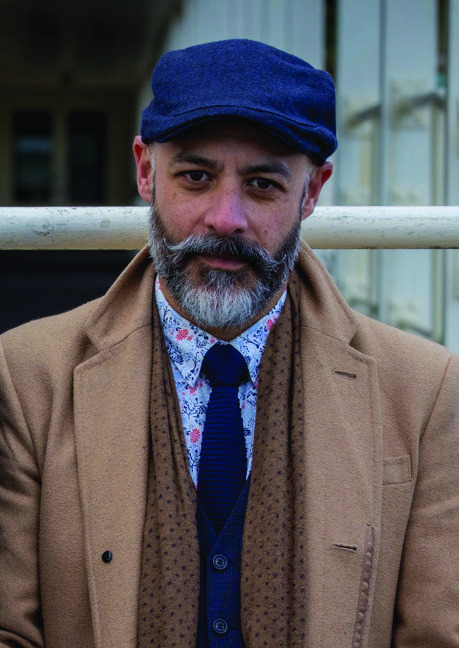
Director James Ashcroft. / Photo by Stan Alley
There’s a strong Māori cast in your film. Do you see yourself as a Māori filmmaker, or a filmmaker who is Maori?
Well, I’m a Māori everything. I’m a father, I’m a husband, I’m a friend. Everything that I do goes back to my DNA and my whakapapa [lineage]. So that’s just how I view my identity and my world. In terms of categorizing it, I don’t put anything in front of who I am as a storyteller. I’m an actor, I’m a director. I follow the stories that sort of haunt me more than anything. They all have something to do with my experience and how I see the world through my identity and my life—past, present and hopefully future.
In terms of the cast, Matthias Luafutu [who plays Mandrake’s sidekick Tubs], he’s Samoan. Miriama McDowell [who plays Jill, the mother of the family] is Māori. I knew that this story, in the way that I wanted to tell it, was always going to feature Māori in some respect. Both the ‘couples’, I suppose you could say—Hoaggie [Erik Thomson] and Jill on one side and Tubs and Mandrake on the other—I knew one of each would be of a [different] culture. So I knew I wanted to mirror that.
Probably more than anything, I knew if I had to choose one role that was going to be played by a Māori actor, it was definitely going to be Jill, because for me, Jill’s the character that really is the emotional core and our conduit to the story. Her relationship with the audience, we have to be with her—a strong middle-class working mother who has a sort of a joy-ness at the beginning of the film and then goes through quite a number of different emotions and realizations as it goes along.
Those are sometimes the roles that Māori actors, I often feel, don’t get a look at usually. That’s normally a different kind of actor that gets those kinds of roles. And then obviously when Miriama McDowell auditions for you it’s just a no-brainer, because she can play absolutely anything and everything. I have a strong relationship with Miriama from drama-school days, so I knew how to work with her on that.
Once you put a stake in the ground with her, then we go, right, so this is a biracial family, and her sons are going to be Māori and that’s where the Paratene brothers, who are brothers in real life, came into the room, and we were really taken with them immediately. We threw out a lot of their scripted dialogue in the end because what we are casting is that fundamental essence and energy that exists between two real brothers that just speaks volumes more than any dialogue that Eli and I could write.

Matthias Luafutu as Tubs in ‘Coming Home in the Dark’.
What was your approach to the locations?
[The area we shot in] is very barren and quite harsh. I spent a lot of time there in my youth, and I find them quite beautiful places. They are very different kinds of landscapes than you normally see in films from our country. We didn’t want to go down The Lord of the Rings route of images from the whenua [land] that are lush mountains and greens and blues, even though that’s what Owen Marshall had written.
I was very keen, along with Matt Henley, our cinematographer, to find that duality in the landscape as well, because the whole story is about that duality in terms of people, in terms of this world, and that grey space. So that’s why we chose to film in those areas.
Regarding the scene where Tubs sprinkles himself with water: including this Māori spiritual element in the film created quite a contrast. That character had partaken in something quite evil, yet still follows a mundane cultural tradition around death. What are your thoughts on that?
Yeah. I’m not really interested in black-and-white characters of any kind. I want to find that grey space that allows them to live within more layers in the audience’s mind. So for me—and having family who have spent time in jail, or knowing people who have gone through systems like state-care institutions as well as moving on to prison—just because you have committed a crime or done something in one aspect of your life, that doesn’t mean that there isn’t room and there aren’t other aspects that inform your identity that you also carry.
It’s something that he’s adopted for whatever reasons to ground him in who he is. And they can sit side by side with being involved in some very horrendous actions, but also from Tubs’ perspective, these are actions which are committed in the name of survival. You start to get a sense Mandrake enjoys what he does rather than doing it for just a means to the end. So any moment that you can start to create a greater sense of duality in a person, I think that means that there’s an inner life to a world, to a character, that’s starting to be revealed. That’s an invitation for an audience to lean into that character.

Erik Thomson and Daniel Gillies in ‘Coming Home in the Dark’.
What is the film that made you want to get into filmmaking?
The biggest influence on me is probably David Lynch’s Blue Velvet. I saw that when I was ten years old. A babysitter, my cousin, rented it. It’s not a film that a ten-year-old should see, by the way. I was in Lower Hutt, there in my aunty’s house, and it was very cold, and there’s a roaring fire going. My cousin and her boyfriend were sitting on a couch behind me, and they started making out. I sort of knew something was going on behind me and not to look. So I was stuck between that and Dennis Hopper huffing nitrous, and this very strange, strange world opening up before me on the television.
I’ve had a few moments like that in my life [where a] film, as well as the circumstance, sort of changed how I view the world. I think something died that day, but obviously something was born. You can see what Lynch did in those early works, especially Blue Velvet. You don’t have to go too far beneath the surface of suburbia or what looks normal and nice and welcoming to find that there’s a complete flip-side. There’s that duality to our world, which we like to think might be far away, but it’s actually closer than you think.
That speaks to Coming Home in the Dark and why that short story resonated with me the first time I read it. Even in the most beautiful, scenically attractive places in our land, many different types of feet walk across those lands, and the land in that sense is quite indifferent to who is on it. I like that duality. I like that sense of we’re never as safe as we would like to think. Blue Velvet holds a special place in my heart.
What other films did you have in mind when forming your approach to Coming Home in the Dark?
Straw Dogs, the Peckinpah film. The original. Just because it plays in that grey space. Obviously times have changed, and you read the film in different ways now as you might have when it first came out. But that was a big influence because there was a moral ambiguity to that film; those lines of good and bad or black and white, they don’t apply anymore. It just becomes about what happens when people are put under extreme pressure and duress, and they abandon all sense of morals. The Offence by Sidney Lumet would be another one, very much drawn to that ’70s ilk of American and English filmmaking.
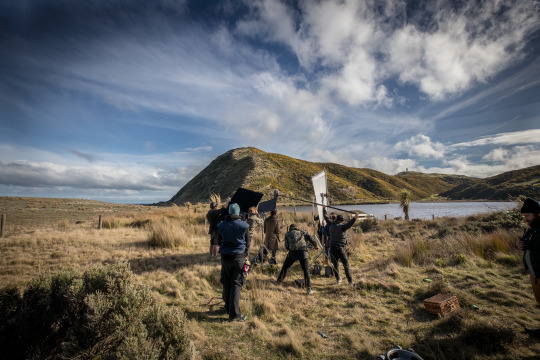
‘Coming Home in the Dark’ was filmed on location around the wider Wellington region of New Zealand.
Is there a New Zealand film that’s influenced you significantly?
There’s a few. I remember watching The Lost Tribe when it was on TV. That really scared me. I just remember the sounds of it. Mr. Wrong was a great ghost story. That stuck with me for a long time. The Scarecrow. Once I discovered Patu! [Merata Mita’s landmark documentary about the protests against the apartheid-era South African rugby tour of New Zealand in 1981], that sort of blew everything out of the water, because that was actually my first induction and education that this was something that even occurred. I think I saw that when I was about eighteen. That this was something that occurred in our history and had ramifications that were other than just a rugby game.
And Utu, every time I watch that, it doesn’t lose its resonance. I get something new from it every time. It’s a great amalgamation of identity, culture, of genre, and again, plays in that grey space of accountability. Utu still has that power for me. It’s one of those films, when it’s playing, I’ll end up sitting down and just being glued to the screen.
It’s a timeless classic. I will admit that when I watched your film, The Scarecrow did immediately come to mind, as did Garth Maxwell’s Jack Be Nimble.
Yeah. [Jack Be Nimble] was really frightening. Again, it was that clash of many different aspects. There was a psychosexual drama there. You’ve got this telekinetic mind control and that abuse and that hunkering down of an isolated family. There are plenty of New Zealand films that have explored a sort of similar territory. They’re all coming to me now.
Bad Blood has a great sense of atmosphere and photography and the use of soundscape to create that shocking sense of isolation and terror in these quick, fast, brutal moments, which then just sort of are left to ring in the air. But I love so much of New Zealand cinema, especially the stuff from the ’80s.
Kia ora [good luck], James.
Kia ora.
Related content
Leo’s Letterboxd list of Aotearoa New Zealand Scary-As Movies Adapted from Literature
Dave’s Cinema of Unease list
A Brutal Stillness: Gregory’s list of patient, meditative genre films
Sailordanae’s list of Indigenous directors of the Americas
Follow Leo on Letterboxd
‘Coming Home in the Dark’ is available now in select US theaters and on VOD in the US and New Zealand. All photographs by Stan Alley / GoldFish Creative. Comments have been edited for length and clarity.
#coming home in the dark#letterboxd#daniel gillies#james ashcroft#maori culture#maori movie#maori director#native director#indigenous film#miriama mcdowell#noir#new zealand noir#leo koziol#imagiNATIVE
3 notes
·
View notes
Photo
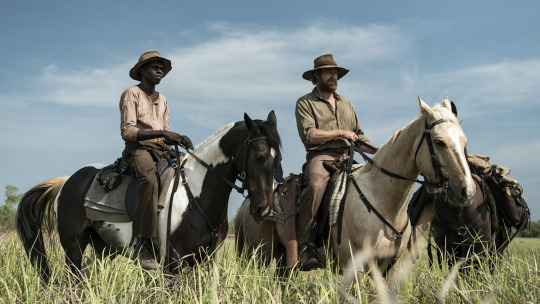
High Ground.
Australian director Stephen Maxwell Johnson tells Letterboxd’s Indigenous correspondent Leo Koziol about his revisionist new meat-pie Western High Ground, working in a ‘both-ways’ style, and how he approaches the question of story sovereignty.
“Maybe we’re all feeling a little more vulnerable, a little more open to thinking about who the fuck we all are in this world.” —Stephen Maxwell Johnson
Note: this interview may contain images and stories of people who have passed away.
Not every Western has a ‘Croc Spotter’ in its production credits, but Australian Westerns are in a league of their own. The genre has long been a staple of Australian cinema; the world’s first narrative feature film is considered to be Charles Tait’s 1906 bushranger yarn about the Kelly Gang. While the likes of outlaw Ned Kelly have made good Western fodder for more than a century now, recent entries in the sub-genre—known colloquially as meat-pie Westerns—are starting to look a little longer and harder at the relationship between British colonizers and the Indigenous peoples of the Great Southern Land.
This year brings two such tales: Leah Purcell’s feminist western The Drover’s Wife: The Legend of Molly Johnson, which made our Best of SXSW 2021 list, and Stephen Maxwell Johnson’s High Ground, which was executive produced by a community of Aboriginal activists, including Witiyana Marika, one of the founding members of groundbreaking Aboriginal band Yothu Yindi. (Marika is also in the film as tribal elder, Grandfather Dharrpa, taking on a role that was intended for Aboriginal great David Gulpilil, who has retired from acting due to ill health.)

Simon Baker as Travis and Jacob Nayinggal Junior as Gutjuk.
Set in Australia post World War I, and based on true stories told by the traditional inhabitants of Arnhem Land, in north-eastern Australia, High Ground opens with—content warning—a brutal massacre by white Australian police of an Indigenous family. The story soon pairs Gutjuk (Jacob Nayinggal Junior, in his impressive screen debut) with bounty hunter Travis (heart-throb Simon Baker, in gnarly outback mode) in a manhunt that brings the opposing forces of colonizers and inhabitants to a head.
Nayinggal Junior, the grandson of Arnhem Land traditional owner Jacob Nayinggal, was not yet born when Johnson, who is a white Australian, began the long process of developing High Ground with his Indigenous partners, whose oral histories informed the film’s plot. Johnson’s connection to Yothu Yindi and his partners’ community goes back over 30 years; he directed the original music video for the band’s 1991 international hit ‘Treaty’, the first Indigenous-language song to chart prominently in Australia.
This is Johnson’s second feature film connected to the Yolngu communities in north-eastern Australia; the first, Yolngu Boy, is a coming-of-age story of three young friends on a journey to Darwin after one of the boys lands in trouble. It has been twenty years since that debut, and High Ground has been a labor of love in the time since.
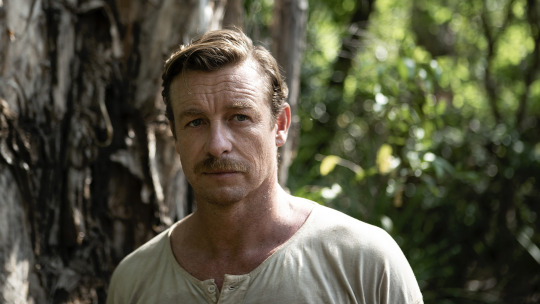
Simon Baker in ‘High Ground’.
The film takes its sound design from the land and its inhabitants, turning the volume up on birds, insects, snakes, gunshots and Aboriginal song. Expansive cinematography makes sure to place characters within the context of their surrounds—a constant reminder that the land is bigger than anything happening on it. “Brutal in all the right ways, and as honest as an Australian colonial Western should be,” writes Coffeenurse. “It’s really something how the Australian Western has become the way for Australian cinema to explore the weight of colonialism and imperialism in our history and culture,” agrees Smoothjazzlord. “Stephen Johnson doesn’t shy away from complexity and I appreciate that,” writes TheEllamo.
I spoke to Johnson at length about his “both-ways” journey of bringing the film to the screen through collective research, song and storytelling.
Notes: ‘Blackfella’ and ‘whitefella’ are informal, self-descriptive terms often used by Indigenous and Aboriginal Australians and their friends. Johnson makes several references to ‘makaratta’, an intricate Yolngu term that describes the process of coming together to face wrongs, reconcile and make peace, and to ‘Country’, which is an Indigenous colloquialism describing one’s association with one’s own land and family.
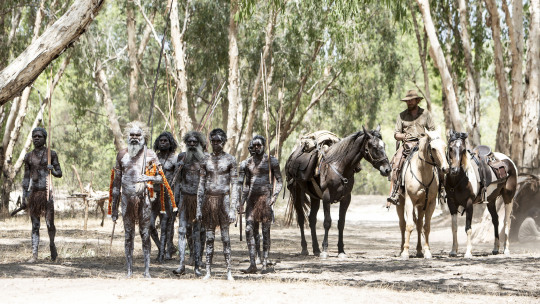
Witiyana Marika (second from left) and Simon Baker (on horse) with Yolngu cast members.
Tell us how the story of High Ground came about.
Stephen Maxwell Johnson: I was very fortunate in my life to have had two parents who explored the world. I grew up in the Bahama Islands, in Africa and they came to northern Australia. My father was an educator of the Yolngu people, and really, my friendships and my associations in my life have been about growing up with Indigenous cultures and people.
I've never really been disconnected from that, and the stories I grew up with—things I’ve heard, ceremonies I’ve seen—were very much a part of my education. I went to school and the stories I’m hearing, all the whitefella stories about Captain Cook and the invasion and what happened, no one ever wanted to go any deeper or open a story book to where it all began, and how old it actually all is.
As you know, it’s the oldest living culture on Earth, it’s an amazing connection to Country and the stories and the songlines. So, we came together, we made a decision to tell a story of the resistance that became High Ground, over many years sitting on Country with old men and women and family and drawing inspiration from true stories and true characters, then putting together what was obviously a fiction (but so is history).
It was about wanting to tell a deeper truth, but to create a film that was entertaining, so it really drew you in, and allowed you to come out the other end to perhaps reflect and rethink the Australia story, and, really, the greater human story about who we all are.
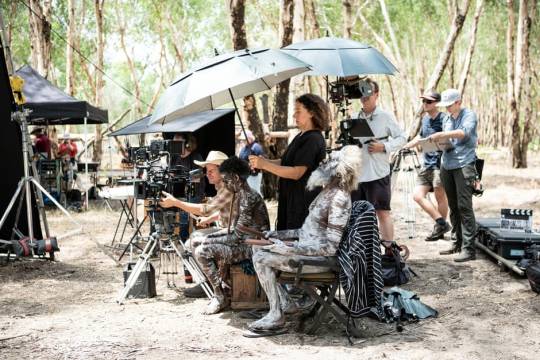
Witiyana Marika (front, seated) on the set of ‘High Ground’.
A unique aspect of your film is that Yothu Yindi band member Witiyana Marika is a producer. How did you connect with Yothu Yindi and establish those friendships?
Well, I did pretty much all of the Yothu Yindi stuff, I made ‘Treaty’ and ‘Djäpana’ and all those clips that the band did. I directed and photographed all of that stuff. For many years, anything that was Yothu Yindi, I was there doing it. Witiyana and Mandawuy [late Yothu Yindi frontman Dr. Mandawuy Yunupingu] were two of my dearest, dearest friends—my father actually knew Mandawuy back in school days, so there’s a deep and long connection there. Witiyana picked up the mantle after Mandawuy passed away. It even goes back further than that, to discussions with old man Bill Neidjie and Jacob Nayinggal, who sort of drew up the battle lines and helped create Kakadu [National Park].
Jacob Junior Nayinggal, he’s been born and became the lead actor; his grandfather would be so pleased that his grandson ended up being the lead actor in this film. ’Cause it was always about getting a Yolngu hero leading the story of the resistance, which was what it was called back in the day.
It’s really been a both-ways journey. That’s what everything that Yothu Yindi sang about, was that idea of bridging between two cultures, that idea of coming together and sharing knowledge and respecting each other. That balance—makaratta. That’s been my journey. That is the journey.
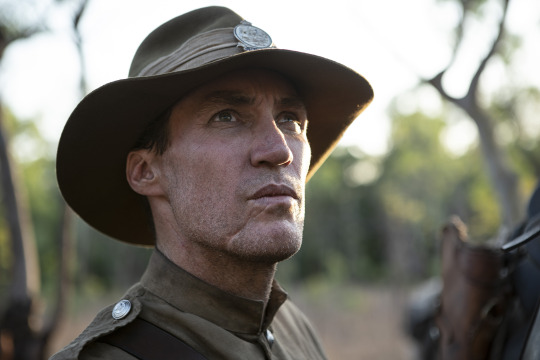
Callan Mulvey as Ambrose in ‘High Ground’.
A big issue for people in the Indigenous film community is storytelling sovereignty: “nothing about us without us”. Do you feel that the community working closely with you to make this film meant that you were telling their story in the way they wanted it seen and heard?
Well if you have a look at the credits it sort of says a lot about the process. Twenty years working together. As I said to you, I don’t see myself as a whitefella over here and they’re blackfellas over there, I see [us] as being human. They’ve been my dearest and closest friends all my life. This is us sitting down, together. Listening. Learning both ways. Bridging the gap and wanting to tell the bigger story about this country.
In this country there’s a very big story to be told. It has two different perspectives and it was about getting that right and spending the time together right. It is very much a Yolngu story; everything has been meticulously researched, and spoken about, and sung. The producers, the executive producers, all the creators in the film are predominantly Yolngu people, right across. Everything is ultimately connected and it is very much the voice of this land that we wanted to shine through in the story of High Ground.
That sort of thing came back in the day, when I made ‘Treaty’: “What’s a whitefella telling [our story]?” Are you kidding me? Mandawuy had the same reaction, he said “We’re doing this together”. Christ almighty we’ve known each other for a lifetime and we’re working together creating and telling stories. There you go. Simple as that. If anyone’s got a problem with that then I think they’re the one with the problem.
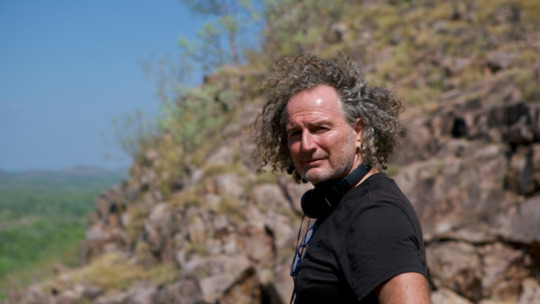
‘High Ground’ director Stephen Maxwell Johnson.
Certainly, Yothu Yindi itself was comprised of both blackfella members and non-blackfellas.
Exactly. Exactly. Look. I’ve grown up with blackfellas from right across Arnhem Land, and it’s been nothing but a deep and beautiful, profound friendship. I’ve never seen it as me and them. We’re just humans. We are one. We share, we care, we love, we laugh. There is so much to be learned from the ancient culture of this country. And the land and the language and the people.
It’s a beautiful thing having that kind of connection and immersion in that world. And that’s been my life story. I’ve been very fortunate to have had that. A lot of people don’t get that experience… being able to work so closely and so deeply with my friends—and family; I was adopted in, as well.
And can I tell you, every single person in Arnhem Land is so proud of this film, it is their film. Their story. It’s been their creative process as well. Every person who is involved in the crew and the journey of the film has had a life-changing experience, for the better. We just hope that the film and the story do help contribute to that bigger conversation, that idea of makaratta and sorting out the shit and getting on with a bit of truth telling.
How was the reaction in the Aboriginal community? Have you had the opportunity to take the film back to the people in Arnhem Land, to have screenings there?
First thing we did. With the elders, that’s what we all planned. They said, “right, as soon as we’ve done this, the first thing we’re going to do, we’re going to bring this back to the families and show it to the families first.” And that’s precisely what we did; we took a big screen out into Arnhem Land, and put it out in the bush, for the families to watch. It was an amazing experience.
Let me tell you, the screams and the applause, and the laughter and the tears, when they saw the film, on their Country. Their film. Their story. Obviously they can listen to the language and the songlines in the film in a completely different way. It was beautiful. I almost couldn’t stop crying. That sense of pride that everyone had in the film, they just own it. It’s theirs and it’s everyone’s. It’s a beautiful way to create something.

The community screening of ‘High Ground’ on the Gunbalanya football field in West Arnhem Land, Australia.
Did you manage to have those screenings happen before Covid-19?
Well, no. The Northern Territories, as you know, was clear. I had to go into quarantine and once the Arnhem Land bio-zone was relieved just a little bit, we took the film out. We had to hit the pause button with Covid, but [then] we did it. People just drove, and flew, and walked from hundreds of miles to come to the place where we blew up the screen and projected the light.
That’s a wonderful story. What’s the reaction been from mainstream Australia?
Look, very, very good. [The film’s distributor] Madman said it made double what [they] thought it would in box office. I think we were fortunate maybe in some respects coming on the back of Covid-19. Maybe we’re all feeling a little more vulnerable, a little more open to thinking about who the fuck we all are in this world. There is this kind of turning of the tide, now, of people and of a new generation wanting to learn and understand about our connection to Country.
We’re blessed with, you know, what we have right here. We need to nurture it, take care of it, respect it, celebrate it, dance it, sing it, talk it. It’s a beautiful thing to be able to tap into.
Thank you Stephen so much for your time. I just want to say I was thoroughly engrossed by your film. It was powerful, it was important. I found particularly the scene in the middle, where a Treaty signing was hinted at: that would have been a cathartic moment for the people of Arnhem Land? To think ‘that could have been what our people had done in the 1930s’, instead of the lack of a Treaty, which Australia has never had. All power to you and everything you’ve done.
That’s beautiful mate, and I will say, just one lovely parting thought here, you know yes, it’s my work, but honestly it’s such a team effort. Such trust, such great friendships and collaborations to create something like this. It’s no one fella’s effort, it’s an incredible team effort.
Related content
Meat-Pie Westerns, Kangaroo Westerns, Australian Westerns: a Letterboxd HQ list
Always Was, Always Will Be, Aboriginal Land: Troy’s list of the best of Aboriginal and Torres Strait Islander “Australia” in film and television
Australian Aboriginal Movies: an extensive list by Wayne
Australian Films Worth Your Time: Jacob’s list of Ocker cinema
My Name is David Gulpilil: Molly Reynolds’ new film celebrating the actor’s extraordinary life
Follow Leo on Letterboxd
‘High Ground’ is available now on digital and VOD via Samuel Goldwyn Films.
#high ground#stephen maxwell johnson#simon baker#callan mulvey#australian cinema#australian film#torres strait islanders#aboriginal and torres strait#aboriginal#aborigine#aboriginal film#northern territory#arnhem land#yolngu#witiyana marika#Jacob Nayinggal Junior#yothu yindi#indigenous film#indigenous cinema#letterboxd#western#meat pie western#kangaroon western#australian western
25 notes
·
View notes
Photo
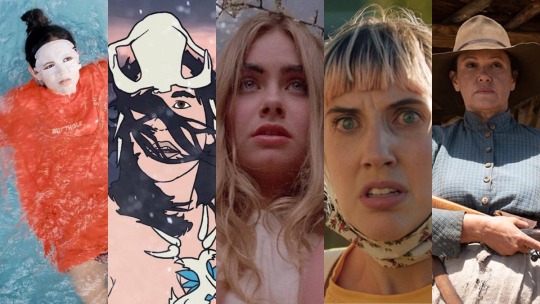
Best of SXSW 2021.
From properly good Covid comedies to an epic folk-horror doc and an Indigenous feminist Western, the Letterboxd Festiville team reveals their ten best of SXSW Online.
We dug out old lanyards to wear around the house, and imagined ourselves queuing up the block from The Ritz (RIP). We dialled into screenings and panels, and did our level best to channel that manic “South By” energy from our living rooms.
The SXSW festival atmosphere was muted, and that’s to be expected. But the films themselves? Gems, so many gems, whether shot in a fortnight on the smell of an oily stimulus check, or painstakingly rotoscoped over seven years.
When we asked SXSW Film director Janet Pierson what she and her team were looking for this year, she told us: “We’re always looking for films that do a lot with little, that are ingenious, and pure talent, and discovery, and being surprised. We’re just looking for really good stories with good emotional resonance.” If there was one common denominator we noticed across this year’s SXSW picks, it was a smart, tender injection of comedy into stories about trauma, grief, unwanted pregnancy, chronic health conditions, homelessness, homophobia and, yes, Covid.
It’s hard to pick favorites, but here are the ten SXSW features and two short films we haven’t stopped thinking about, in no particular order.

Recovery
Directed by Mallory Everton and Stephen Meek, written by Everton and Whitney Call
“Covid 19 is in charge now” might be the most hauntingly funny line in a SXSW film. In Recovery, two sisters set out on a haywire road trip to rescue their grandmother from her nursing home in the wake of a severe Covid 19 outbreak. There’s no random villain or threat, because isn’t being forced to exist during a pandemic enough of a threat in itself? If ever we were worried about “Covid comedies”, SXSW managed to flush out the good ones. (Read about the Festiville team’s other favorite Covid-inflected comedies, including an interview with the directors of I’m Fine (Thanks for Asking).)
Alex Marzona praises the “off-the-charts chemistry” between leads Mallory Everton and Whitney Call. Best friends since they were nine, the pair also wrote the film, with Everton co-directing with Stephen Meek. Every laugh comes from your gut and feels like something only the cast and crew would usually be privy to. “You can tell a lot of the content is improvised, which just attests to their talent,” writes Emma. Recovery doesn’t make you laugh awkwardly about how awful the last year has been—rather, it reminds you that even in such times there are still laughs to be had, trips to be taken, family worth uprooting everything for. Just make sure you’ve packed enough wet wipes for the road, and think long and hard about who should babysit your mice. —EK

The Spine of Night
Written and directed by Morgan Galen King and Philip Gelatt
Don’t get too attached to any characters from its star-studded cast—nobody is safe (or fully-clothed) in The Spine of Night’s raw, ultra-violent and cynical world. Conjured over the last seven years, directors Philip Gelatt and Morgan Galen King’s rotoscoped epic recaptures the dazzling imagination and scope of their influences Ralph Bakshi and Heavy Metal. Approaching an anthology-style structure to explore how ‘absolute power corrupts absolutely’—a proverb more potent now than when Gelatt and King began their project—the film packs a franchise’s worth of ideas in its 90-minute runtime. Though the storytelling justifiably proves itself overly dense for some, it will find the audience it’s after, as other Letterboxd members have declared it “a rare treat” and “a breath of fresh air in the feature-length animation scene”. For sure, The Spine of Night can join Sundance premieres Flee and Cryptozoo in what’s already a compelling year for unique two-dimensional animation. —JM
Kambole Campbell caught up with Gelatt and King (who are also Letterboxd members!) during SXSW to talk about animation inspirations and rotoscoping techniques.
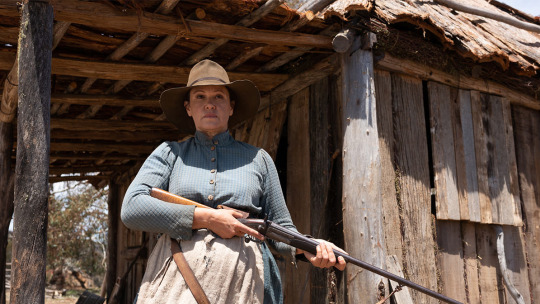
The Drover’s Wife: The Legend of Molly Johnson
Written and directed by Leah Purcell
Snakes, steers and scoundrels beware! Writer-director-star Leah Purcell ably repurposes the Western genre for Aboriginal and female voices in The Drover’s Wife. Molly Johnson is a crack-shot anti-heroine for the ages, in this decolonized reimagining of a classic 1892 short story by Henry Lawson. And by reimagining, we mean a seismic shift in the narrative: Purcell has fleshed out a full story of a mother-of-four, pregnant with her fifth, a missing husband, predatory neighbors, a mysterious runaway and a young English couple on different paths to progress in this remote Southern land. Purcell first adapted this story for the stage, then as published fiction; she rightly takes the leading role in the screen version, too.
As a debut feature director, Purcell (Goa-Gunggari-Wakka Wakka Murri) already has a firm grip on the macabre and the menacing, not shying away from violence, but making very careful decisions about what needs to be depicted, given all that Molly Johnson and her family are subjected to. She also sneaks in mystic touches, and a hint of romance (local heartthrob Rob Collins can take us on a walk to where the Snowy widens to see blooming wildflowers anytime). Judging by early Letterboxd reviews, it’s not for everyone, but this is Australian colonization through an Indigenous feminist’s eyes, with a fierce, intersectional pay-off. “Extremely similar to a vast majority of the issues and themes explored in The Nightingale,” writes Claira. “I’m slowly realizing that my favorite type of Westerns are Australian.” —LK, GG

Swan Song
Written and directed by Todd Stephens
Udo Kier is often the bridesmaid, rarely the bride. Now, after a lifetime of supporting roles ranging from vampires and villains to art-house muse, he finally gets to shine center-stage in Swan Song. Kier dazzles as a coiffure soothsayer in this lyrical pageant to the passage of queer times in backwater Sandusky, Ohio. “He is absolutely wonderful here,” writes Adrianna, “digging deep and pulling out a mesmerizing, deeply affecting and emotionally textured performance, proving that he’s an actor with much more range than people give him credit for.”
A strong supporting cast all have melancholy moments to shine, with Linda Evans (Dynasty), Michael Urie (Ugly Betty) and Jennifer Coolidge (Legally Blonde) along for the stroll. Surreal camp touches add joy (that chandelier, the needle drop!) but by the end, the tears roll (both of joy and sadness). Writer-director Todd Stephens ties up his Sandusky trilogy in this hometown homage, a career peak for both him and Kier. Robert Daniels puts it well, writing that Swan Song is “campy as hell, but it’s also a heartfelt LGBTQ story about lost lovers and friends, vibrant memories and the final passage of a colorful life.” —LK
Leo Koziol spoke with Todd Stephens and Udo Kier during SXSW about Grace Jones, David Bowie and dancing with yourself.
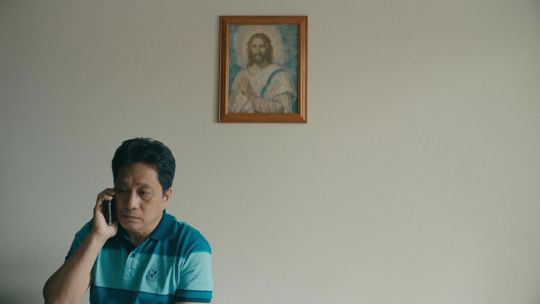
Islands
Written and directed by Martin Edralin
Islands is a Mike Leigh-esque story that presents a Canadian Filipino immigrant family full of quirk and character, centered around Joshua, a reticent 50-year-old homebody son. The story drifts in and out of a deep well of sadness. Moments of lightness and familial love make the journey worthwhile. “A film so Filipino a main plot device is line-dancing,” writes Karl. “Islands is an incredibly empathetic film about what it’s like to feel unmoored from comfort. It’s distinctly Filipino and deals with the psychology of Asian culture in a way that feels both profound and oddly comforting.” In a year in which we’ve all been forced to physically slow down, Islands “shows us how slow life can be,” writes Justin, “and how important it is to be okay with that.” Rogelio Balagtas’s performance as Joshua—a first-time leading role—won him the SXSW Grand Jury Award for Breakthrough Performance. —LK

Ninjababy
Directed by Yngvild Sve Flikke, written by Flikke with Johan Fasting and Inga H. Sætre
Ninjababy is as ridiculous as its title. When 23-year-old Rakel finds herself accidentally pregnant, scheduling an abortion is a no-brainer. But she’s way too far along, she’s informed, so she’s going to have to have the baby. The ensuing meltdown might have been heartbreaking if the film wasn’t so damn funny. Ninjababy draws on the comforting and familiar (“Lizzie McGuire if she was a pregnant young adult,” writes Nick), while mixing shock with originality (Erica Richards notices “a few aggressive and vulgar moments [but] somehow none of it seemed misplaced”).
An animated fetus in the style of Rakel’s own drawings appears to beg and shame Rakel into motherhood while she fights to hold onto her confidence that not wanting to be a mother doesn’t make her a bad person. Ninjababy’s greatest feat is its willingness to delve into that complication: yes, it’s righteous and feminist and 21st-century to claim your own body and life, but that doesn’t mean it’s easy to turn away from something growing inside of you. It’s a comedy about shame, art, finding care in unlikely places—and there’s something in it for the gents, too. The titular ninjababy wouldn’t leave Rakel alone, and it’s unlikely to leave you either. Winner of the SXSW Global Audience Award. —SH
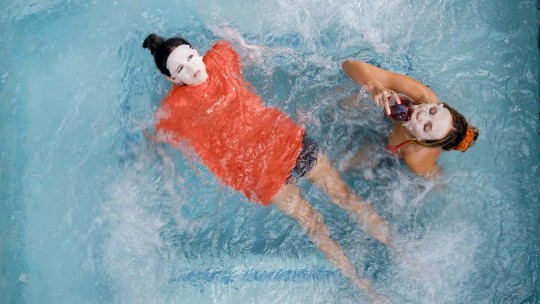
The Fallout
Written and directed by Megan Park
Canadian actress Megan Park brought the youthful wisdom of her days on the teen drama series The Secret Life of the American Teenager to her first project behind the camera, and it paid off. Following the scattered after-effects of a school shooting, The Fallout may be the most acute, empathetic depiction of childhood trauma on screen in recent memory. “It sneaks up on you with its honesty and how it spends time with its lead, carried so beautifully by Jenna Ortega. Even the more conventional moments are poignant because of context,” writes Kevin L. Lee. Much of that “sneaky” honesty emerges as humor—despite the heavy premise, moments of hilarity hang on the edges of almost every scene. And Ortega’s portrayal of sweet-but-angsty Vada brings self-awareness to that humor, like when Vada’s avoidant, inappropriate jokes with her therapist reveal her desperation, but they garner genuine laughs nonetheless.
In this debut, Park shows an unmatched understanding of non-linear ways that young people process their pain. Sometimes kids try drugs! Sometimes they scream at their parents! But more often than not, they really do know what they want, who loves them, and how much time they need to grieve (see also: Jessie Barr’s Sophie Jones, starring her cousin Jessica Barr, out now on VOD and in theaters). The Fallout forsakes melodrama to embrace confusion, ambiguity and joy. Winner of both the SXSW Grand Jury and Audience Narrative Feature Awards, and the Brightcove Illumination Award. —SH

Ludi
Directed by Edson Jean, written by Jean and Joshua Jean-Baptiste
When Ludi begins, it’s quiet and dreamy. The film’s opening moments conjure the simple pleasures of the titular character’s Haitian heritage: the music, the colors, the people. Ludi (Shein Monpremier) smiles to herself as she starts her morning with a tape recording her cousin mailed from Haiti to Miami, and listens as her family members laugh through their troubles before recording an upbeat tape of her own. But that’s where the dreaminess ends—Ludi is an overworked, underpaid nurse picking up every shift she possibly can in order to send money home. Writer-director Edson Jean fixates on the pains and consequences of Ludi’s relentless determination, which comes to a head when she moonlights as a private nurse for an old man who doesn’t want her there.
Ashton Kinley notes how the film “doesn’t overly dramatize or pull at false emotional strings to make its weight felt. The second half of the feature really allows all of that to shine, as the film becomes a tender and empathetic two-hander.” George’s (Alan Myles Heyman) resentment of his own aging body steps in as Ludi’s antagonist. Jean throws together jarring contrasts: George throwing Ludi out of the bathroom, followed by Ludi’s memories of home, followed by another lashing out, followed by a shared prayer. The tension is unsustainable. By interspersing the back-breaking predicament of a working-class immigrant with the sights and sounds of the Caribbean, Ludi elegantly, painfully reveals what the cost of a dream can be. —SH
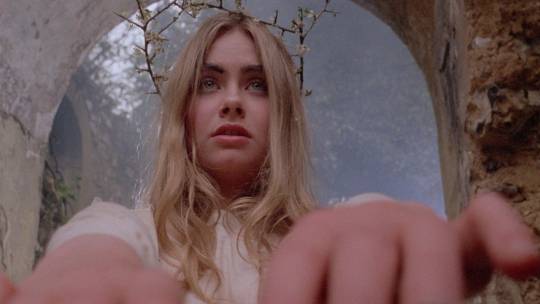
Woodlands Dark and Days Bewitched: A History of Folk Horror
Written and directed by Kier-La Janisse
Building on the folk horror resurgence of films like The Witch and Midsommar, Kier-La Janisse’s 193-minute documentary Woodlands Dark and Days Bewitched is a colossal, staggering undertaking that should school even the most seasoned of horror buffs. “Thorough is an understatement,” says Claira.
Combining a historian’s studied, holistic patience with a cinephile’s rabid, insatiable thirst, the film, through the course of six chapters, broadens textbook British definitions, draws trenchant socio-political and thematic connections, debunks myths and transports viewers to far-flung parts of the globe in a way that almost feels anthropological. As Jordan writes, “Three hours later and my mind is racing between philosophical questions about the state of hauntology we generationally entrap ourselves in, wanting to buy every single one of the 100+ films referenced here, and being just a bit in awe of Janisse’s truly breathless work.” An encyclopedic forest worth losing yourself in—get ready for those watchlists to balloon. Winner of the SXSW Midnighters Audience Award. —AY

Introducing, Selma Blair
Directed by Rachel Fleit
There’ll likely be some level of hype when this intimate collaboration between actress Selma Blair and filmmaker Rachel Fleit comes out later in the year on Discovery+, and that’s okay, because that is Blair’s intention in sharing the details of her stem-cell transplant for multiple sclerosis. There’d be little point in going there if you are not prepared to really go there, and Introducing, Selma Blair is a tics-and-all journey not just into what life is like with a chronic condition, a young son, and a career that relies on one’s ability to keep a straight face. It’s also an examination of the scar tissue of childhood, the things we are told by our parents, the ideas we come to believe about ourselves. “I almost felt like I shouldn’t have such intimate access to some of the footage in this documentary,” writes Andy Yen. “Bravo to Selma for allowing the filmmakers to show some truly raw and soul-bearing videos about her battle with multiple sclerosis that make us feel as if we are as close to her as family.” —GG
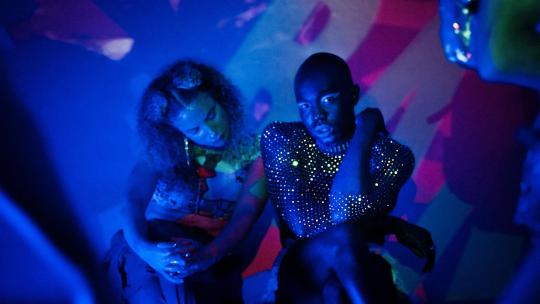
Femme
Directed by Sam H. Freeman and Ng Choon Ping
I May Destroy You fans, rejoice: Paapa Essiedu, who played Arabella’s fascinating best friend Kwame, takes center stage in Sam H. Freeman and Ng Choon Ping’s intoxicating short film Femme. It’s a simple premise—Jordan, a femme gay man, follows his drug dealer (Harris Dickinson, mastering the sexually repressed brusque young man like no one else) home to pick up some goods on a night out. Except, of course, it’s not that simple. The co-directors build a world of danger, tension and electricity, with lusciously lensed scenes that lose focus as the threat rises. Frankie calls it “hypnotizing and brutal and gorgeous” and we couldn’t agree more. A crime thriller wrestling with hyper-masculinity seen through the eyes of an LGBTQ+ character, with a sucker-punch ending to boot, the world needs more than twenty minutes of this story. —EK

Play It Safe
Directed by Mitch Kalisa
If you (unwisely) thought that the vulnerable, progressive environment of drama school would be a safe space for Black students, Play It Safe confirms that even a liberal bunch of actors (and their teacher) are capable of being blind to their own egregiously racist microagressions. Mitch Kalisa’s excellent short film explores structural prejudice head-on, in an electric acting exercise that rests on where the kinetic, gritty 16mm camera is pointing at every pivotal turn. At first, we’re with Black drama student Jonathan Ajayi as he receives the assignment; then we are with the rest of the class, exactly where we need to be. “Literally in your face and absolutely breathtaking,” writes Nia. A deserving winner of the SXSW Grand Jury and Audience narrative shorts prizes. —GG
Follow the Festiville team on Letterboxd
#sxsw#south by southwest#sxsw 2021#sxswonline#SXSW Film#janet pierson#film festival#letterboxd#letterboxd best
7 notes
·
View notes
Text
Die Wahrheit über Peter Pilz
Neuer Beitrag veröffentlicht bei https://melby.de/die-wahrheit-ueber-peter-pilz/
Die Wahrheit über Peter Pilz
Von Journalisten wird Peter Pilz immer noch als angeblicher Aufdecker verteidigt, wenngleich sie seine Verhaltensweisen zunehmend abstoßen. Davon beeinflusst meinen viele tatsächlich, dass es sich um einen Aufdecker und nicht um einen Agenten handelt, und knüpfen daran auch Hoffnungen, dass noch so manch ein Skandal aufgeklärt wird. Weil Pilz immer dann abtaucht, wenn er einmal seinen Mann stehen müsste, fällt seine Liste jetzt durch Querelen auf, die durchaus unterhaltsamen Charakter haben. So wird deutlich, dass die Kombination ältere Männer – jüngere Frauen sexistische Gründe hat, denn Frauen haben hier den Part der Lernenden, der Unterlegenen. Da setzen sich dann zwei Männer im Pensionsalter zu einer Pressekonferenz hin und verkünden, dass sie beide Klubobmann sein werden, den jungen Frauen aber die Zukunft gehört, weil sie „Potenzial“ haben. Für Pilz und seine Haberer war immer undenkbar, das Wissen und die Erfahrungen von älteren Frauen zu schätzen, denn das hätte Gleichwertigkeit bedeutet und Pilz‘ Mission durcheinandergebracht.
Peter Kolba, der vor ein paar Tagen via Twitter aus dem Liste Pilz-Klub ausgeschieden ist, sprach in einem Interview gönnerhaft von Schlußfolgerungen aus seiner jahrzehntelangen Verhandlungserfahrung, die ihm „30jährige Mäderln“ wohl nicht glauben wollen. Es war aber gerade Kolba, für den Vorwürfe sexueller Belästigung gegen Pilz substanzlos und eine Verschwörung waren. Als Martha Bißmann, die im November für Pilz nachgerückt war, nun nicht wieder Platz machen wollte, zog Kolba auf Facebook und Twitter über sie her und kam mit der nächsten Verschwörung einer durchtriebenen jüngeren Frau. Es ist vielleicht kein Zufall, dass die überhebliche ältere Herren-Liste ein Belästigungsproblem hatte, denn auch ohne zu grabschen sind manche in gewissem Sinn übergriffig. Da erzählt uns ein 59jähriger Mann, dass junge Frauen von älteren Männern in der Liste Pilz geformt werden müssen, ist aber selbst so naiv, dass er die Rolle von Pilz bis heute nicht durchschaut. Oder geht es darum, wie man(n) vor sich selbst dasteht, wenn er erkennt, dass er ungeheuer verarscht wurde? Vor einigen Jahren, im Alter von 29, war mir klar, dass Pilz für die Amerikaner arbeitet, denn er forderte US-Militärinterventionen und die Grünen hatten einzustimmen; wer gegen Pilz und seine Agenda auftrat, wurde aus dem Hinterhalt diffamiert. Es wurde also verdeckt operiert, teilweise auch mittels Personen, die vorgeschickt wurden, ohne dass sie verstanden, warum sie etwas zu vertreten oder jemanden anzufeinden hatten.
Bild, das auf Twitter geteilt wird
Auch da war Pilz übrigens auf Tauchstation – am 3. August 1992 „profil“-Interview mit dem O-Ton „Belagerungsringe sprengen“ (in Bosnien, Präsident war da noch George Bush, CIA-Chef zur Zeit des Lucona-Untergangs 1977), dann ward er wochenlang nicht mehr gesehen, und die Kritiker kamen nicht in die Medien und wurden diffamiert; der Parlamentsklub war sofort auf Linie. Als ich 26 war, wurde ich auf perfide Weise gegenüber dem damaligen formalen Parteichef Johannes Voggenhuber verleumdet; ich verstand, dass es darum ging, eine Frau auf ihn anzusetzen. Wenn dir jemand ausweicht, es auch noch keine Handys und keine sozialen Medien gab, dann kannst du als Notlösung einen Brief schreiben. Als ich das tat und Voggenhuber warnte, dass ich ihm gegenüber berechnend erscheinen soll, damit er dafür blind wird, dass andere etwas wirklich Böses mit ihm im Schilde führen, zeigte er es ausgerechnet Pilz. Es ging damals auch darum, die Rolle von Pilz als „Aufdecker“ (zuerst Lucona, dann Noricum) abzusichern, nachdem mit dem Rücktritt von Freda Meissner-Blau und Walter Geyer der Platz für Pilz im Lucona-U-Ausschuss frei war, wo er sich zu Fredas Ensetzen von Hans Pretterebner beraten ließ. Pilz marschierte dann zum ersten Mal in eine Vorstandssitzung der Wiener Grünen, die mich mit einem Kommunalprogramm beauftragen wollten und hielt eines seiner Standpilzgerichte ab.
Offenbar waren die damals noch bescheidenen Erkenntnisse in besagtem Brief eine Gefährdung für ihn und seine Rolle; ich erfuhr später, dass er mich aus der Partei ausschließen lassen wollte. Als ich Pilz ein paar Jahre danach den Amerikanern zuordnete, tat ich dies auch bei Sonja Puntscher Riekmann, die sich Voggenhubers angenommen hatte. Damals lernte ich, wie man verdeckte Aktionen erkennt und deutete zunächst in einem Artikel an, was einer „deklarierten Feministin“ so alles unterstellt wurde, und prompt kamen Reaktionen mit Andeutungen über Personen, die nichts ahnten. Mit 29 brauchte ich keinen „alten Sack“, der mich politisch unter seine Fittiche nimmt, stand aber mit absolut nichts da, weil ich exakt rekonstruierte, was in den Grünen verdeckt passiert. Was Pilz‘ Freund Wolfgang Fellner jetzt schreibt, ist auch verständlich vor dem Hintergrund gemeinsamer Lucona- und Noricum-„Aufdeckerei“. Denn er ist bestrebt, ihn immer noch als „Aufdecker“ zu feiern, wenn er ihm zugleich den Gnadenstoß gibt: „Was bleibt vom mutigen, heldenhaften Aufdecker der Nation, dem wir alle so viele Vorschuss-Lorbeeren mitgegeben haben?“ Es gibt da kein „wir alle“, weil es einige im Lauf der Zeit durchschauten, aber dies niemals Mainstream wurde, also keine Breitenwirkung entfaltete.
Kolba-Bonmots auf Twitter
„Er war als Aufdecker der Beste. Als Redner brillant. Als Medien-Star ein Genie. Als Abgeordneter wichtig. Ich mag ihn“, schreibt Fellner weiter. Wie sehr Pilz zudeckte, kann man sich z.B. bei den Eurofightern ansehen. Bedingt auch durch meine Erfahrungen damit, was Geheimdiensten so einfällt, um Personen von Interesse unter Kontrolle zu bringen, war für mich nie rätselhaft, warum Ex-Verteidigungsminister Norbert Darabos nie z.B. mit dem BMLV-eigenen Eurofighter-Experten sprechen durfte. Er ist schlicht zu clever, um sich von einer Agentin einwickeln zu lassen, will nicht freiwillig kooperieren und ist zumindest als Vater erpreßbar. Natürlich weiß auch gerade Pilz, was alles möglich ist, da er ja sozusagen live dabei war, wie der zu unabhängige Voggenhuber in die Falle gelockt wurde. Im Grunde braucht man nur eine Variable zu verändern: es war nicht machbar, mich gegenüber Darabos, der mich kennenlernen wollte, nachdem ich ihn gegen Kritik verteidigte, berechnend erscheinen zu lassen. Also drehte man es mit Drohungen und Verleumdungen u.a. via Kammerhofer so, dass ich in den Augen anderer berechnend wirken sollte, weil es ja nicht sein kann, dass eine Frau sich erstens für Sicherheitspolitik interessiert und zweitens die Situation exakt erfassen kann, in der sich der Minister befindet.
Bei verbreiteter Männerdummheit unter dünnem zivilsatorischem Firnis, wie sie nicht nur in Kolba-Postings deutlich wird, ist das keine Überraschung. Denn für die meisten ist es etwas vollkommen anderes, ob ein Minister nicht mit Offizieren oder nicht mit einer Journalistin reden darf. Und die Vorstellung geht schon gar nicht, dass eine Frau, eine Zivilistin dort Mut hat, wo sich Offiziere nichts zutrauen oder nichts begreifen. Mit anderen Worten hätte „Aufdecker“ Pilz in die Bresche springen müssen, aber er spielte mit Kabinettschef Stefan Kammerhofer zusammen, der Darabos abschottete und verfassungs- und rechtswidrig selbst Befehle und Weisungen erteilte. Tatsächlich kommen einem „Aufdecker“ unter, wenn man sich in die Protokolle von U-Ausschüssen vertieft – etwa Maria Fekter (ÖVP), die im 1. Eurofighter-Ausschuss bei der Befragung von Abwehramtschef Erich Deutsch zutage förderte, dass Kammerhofer nie überprüft wurde und man auch keinerlei Verdachtsmomenten nachging. Als Fekter kritisierte, dass Darabos bei seinen Befragungen Kammerhofer als „Vertrauensperson“ mithatte und dieser ihm jede Antwort vorsagte, fuhr ihr Ausschussvorsitzender Peter Pilz energisch in die Parade.
youtube
Fellner interviewt Pilz (Mai 2018)
Im Eurofighter-Ausschuss 2017 hat der gesamte Ablauf sehr viel mit Pilz zu tun, da bereits das Zustandekommen darauf aufbaut, dass Pilz der militärische Verschlußakt Vergleich mit EADS zugespielt wurde. Pilz nahm von Anfang an Darabos ins Visier und Medien und Ausschuss folgten ihm, indem er darüber hinwegsah, dass der Minister die Finanzprokuratur mit Verhandlungen beauftragte, aber der unzuständige Kabinettschef dies widerrief, damit ein unerfahrener Theoretiker, Professor Helmut Koziol, an deren Stelle tritt. Obwohl Koziol über Ex-Bundeskanzler Alfred Gusenbauer bzw. dessen Anwalt und nunmehrigen Geschäftspartner Leo Specht ins Spiel kam, blendete der „Aufdecker“ dies aus und zeigte erwartungsgemäss Darabos wegen des Vergleichs bei der Staatsanwaltschaft an. Ein über Agent Pilz, der ja ein „Staraufdecker“ sein soll, etablierter Narrativ führt dazu, dass die meisten etwas glauben ohne zu realisieren, dass es nicht mit Fakten untermauert ist, diese im Gegenteil allem widersprechen und ein ganz anderes Bild ergeben. Wenn Fellner seinem Freund rät: „Mach Schluss, Alter. Lös deine Partei auf. Schick deine gierigen Streithansln nach Hause. Und entschuldige dich bei deinen Wählern. Das wäre das Mindeste…“ so bedeutet das auch, dass Pilz billig nach jahrzehntelanger Bereicherung auf unser aller Kosten, nach unendlich viel angerichtetem Schaden davon kommen soll.
Einige seiner Kollateralschäden haben nichts Besseres verdient, etwa Ex-Verteidigungsminister Hans Peter Doskozil, der aus dem Unglück seines Parteigenossen Darabos Profit schlug und Pilz auf die „Wir gegen den großen Rüstungskonzern“-Masche reingefallen ist. Oder SPÖ-Klubobmann Christian Kern, der als echter Pilz-Jünger einen BVT-Megaskandal dort sieht, wo Dinge langsam wieder in Ordnung kommen, und sich von Pilz briefen hat lassen. Wenn Pilz zum ersten Mal in seinem Leben Verantwortung übernimmt, bedeutet das, Schäden wiedergutzumachen, soweit dies möglich ist. Wo seine Lügen, Verleumdungen, Desinformationen Menschen materiellen Schaden zufügten, hat er diesen zu ersetzen. Zu diesem Personenkreis gehöre ich nicht nur wegen früherer grüner Erfahrungen, sondern auch, weil ich wegen der Wahrheit über die Zustände im BMLV massivst existentiell geschädigt wurde. Und Pilz mit seinem gesamten Wirken und nicht zuletzt mit der Anzeige gegen Darabos die wahre Situation verschleierte, von ihr ablenkte, Druck auf ein Regierungsmitglied kaschierte, Wäre Pilz jetzt Abgeordneter, würde er sich wohl über die Golan-Affäre empören und Darabos attackieren, der angab, dass er ein Schreiben von Generalstabschef Edmund Entacher nie erhalten hat (i.e. Kammerhofer hat es wie üblich einkassiert).
youtube
Rainer Nowak, „Die Presse“, und Peter Pilz
Doch halt, Pilz bekommt ja ein Abgeordnetengehalt, zuerst aus Spenden, tritt jedoch fast nie in Erscheinung. In der „Kleinen Zeitung stand am 15. Jänner 2018 zur Klubklausur der Liste Pilz über Peter P.: „Der gebürtige Obersteirer ist derzeit ohne Einkommen, weder hat er Anspruch auf eine Gehaltsfortzahlung durch das Parlament, noch ist er als Mitarbeiter bei seinem Klub beschäftigt.“ Selbst das reden sich manche noch schön, wie man an diesem Posting sieht, denn Pilz radle gemütlich durch Kärnten, während seine Liste im Chaos versinkt. Pilz dementierte das Einkommen zuerst, als die „Presse“ berichtete und es oe24 aufgriff, um dann in „Österreich“ zum Angriff überzugehen, weil er eben nicht von Airbus und Haselsteiner abhängig sein wolle. Allerdings schweigt er zu Haselsteiner, und sein Kampf gegen den europäischen Konzern nutzt Lockheed und Boeing. Und wenn er abtaucht, wird dies im ORF vor laufender Kamera abgenickt – am 31. Mai berichtete Hans Bürger in der Zeit im Bild allen Ernstes, dass er nur eine SMS von Pilz habe, der sich jetzt mit seiner Frau besprechen müsse. Wie man am unten abgebildeten Kolba-Tweet erkennen kann, hat es eine merkwürdige Bewandtnis mit dem Pilz-Gehalt, zumal er ja jederzeit auf seinen Ruhebezug als Abgeordneter zugreifen hätte können. Wäre das eine magische Handlung, die eine Rückkehr ins Parlament verhindert? Oder ist Pilz so dermaßen geizig, dass er jeden Cent an sich rafft, was jenen Menschen plausibel erscheint, die naiv annahmen, er sei an einer Basisorganisation interessiert und man könne Büros vor Ort um ein paar tausend Euro anmieten.
Gegenüber Fellner kam er zuerst damit, dass er ja dumm wäre, würde er Gehalt aus Spenden bezahlen lassen; dann aber dementierte er nicht mehr, sondern stellte sich als Kämpfer gegen Airbus und Co. dar. Das kann frau fast nur vor Wut bebend schreiben, da ich kaum mehr etwas besitze, weil ich gegen die via Pilz durchgezogene, gegen die Republik Österreich gerichtete Agenda aufgetreten bin. Dies auch weil ich als gebranntes ehemaliges grünes Kind wahrscheinlich besser als andere verstand, wie sehr Darabos zugesetzt wird. Doch nüchtern betrachtet stellt sich die Frage, was Pilz verschleiern will, indem er ununterbrochen ein Einkommen bezieht, auch wenn er dann Urlaube zu Arbeitswochen erklären muss (wie man in Fellner.Interviews gut sehen kann, siehe März 2018 und siehe Mai). Fellner schreibt dazu übrigens: „Und zuletzt wurde auch noch aus Pilz, dem Aufdecker, ein Pilz, der Abkassierer. Ein Saubermann, der während er auf Urlaub war, schamlos von der Partei aus Spenden- und Steuergeldern ein Mega-Gehalt kassierte, der seinen Abgeordneten-Hiwis für den Mandatsverzicht horrende Summen bietet, seine Klubchef gleich doppelt bezahlt.“ Bruno Rossmann und Wolfgang Zinggl teilen sich nach dem öffentlichen Aufschrei ein Klubobmann-Gehalt zusätzlich zum Abgeordnetensalär.
Peter Kolba auf Twitter
Die beiden hat Pilz übrigens von den Grünen mitgenommen, deren Rolle er im Interview mit Rainer Nowak weiter oben recht klar skizziert. Da ist nichts von emotionaler Bindung, sondern er hakt seine Aufgabe in der Partei ab und soll diese dann offenbar zerstören. Ich wollte die Grünen vergeblich warnen, dass er keine Sekunde mehr an sie denkt und kein Konkurrent wie jeder andere ist, sondern nach einem Drehbuch (aus Langley) vorgeht. Und wie schreibt Fellner aktuell? „Unglücklicher, patscherter, aber auch unverschämter als er hat noch keiner seine Wähler betrogen. Er war die Hoffnung von Hunderttausenden Bürgern, die endlich einen Aufklärer und einen frischen Wind und eine härtere Gangart im schläfrigen Parlament wollten – und die dafür sogar die pensionsreifen Grünen aufs Reservebankerl geschickt haben.“ In Wahrheit hat er zahlreiche kritische Menschen aus den Grünen vertrieben, während es Angepasste und Unpolitische leicht hatten. Es ist ein was wäre, wenn, doch echte unabhängige Grüne hätten einiges bewirken können. Das aber war nicht sein Auftrag, während er mit einer neuen Partei eine Solistenrolle einnehmen sollte. Für Peter Kolba rückt Maria Stern nach, die bis 6.Juni Bedenkzeit hat; verzichtet sie, kann Pilz-Freund und Anwalt Alfred Noll ihr Mandat übernehmen, um seinen Platz für Pilz freizumachen.
Man würde erwarten, dass jemand wie Pilz selbst klarkommen soll, also tatsächlich ohne offizielle Rückendeckung arbeitet. Doch er hatte immer eine Heerschar an helfenden Händen – Kommentatoren, die ihn willig hochschrieben, Journalisten, die nach dem gierten, was ihnen via Pilz an Material zugespielt wurde. Es war vollkommen egal, ob Pilz innerhalb der Grünen unsympathisch war, weil er immer auf Leute losging, sie einschüchterte, nebulose Andeutungen machte, weil er mit welchen Infos auch immer versorgt wurde. Denn er war stets der Liebling der Medien, was ihm dabei half, Themen und Ansichten in den Grünen vorzugeben und diejenigen zu attackieren, die sich in den Weg stellten (was sich puncto Karrierechancen und Finanzen stark auswirkte). Es mag so wirken, als habe sich Pilz den im November 2017 erstmals offen erhobenen Belästigungsvorwürfen stellen müssen. Doch er ging auf Tauchstation, kündigte Urlaub an (und ließ dies mit Spenden bezahlen) und war nicht mehr zu sprechen, konnte auch nicht z.B. für den Eurofighter-Hoax zur Verantwortung gezogen werden. Pilz hatte immer noch genug Helfer, damit er mit diesem Verhalten durchkam und geradezu sehnsüchtig auf seine Rückkehr gewartet wurde. Denn es stehen ja zwei U-Ausschüsse an, und die wird er wie üblich durcheinanderwirbeln, das wird eine Abrechnung mit der Bundesregierung. Doch statt alles auf die eigene Kappe zu nehmen, kann er keine fünf Sekunden ohne verdeckte Unterstützung aus dem Hintergrund durchstehen.
Gefällt mir:
Gefällt mir Lade …
Ähnliche Beiträge
Ceiberweiber
alexandrabader
Quelle
قالب وردپرس
0 notes